This is the most detailed Force USA G10 review that you are going to find on the internet!
I’m going to give you ALL of my insights on the Force USA G10 All-In-One Trainer so you can figure out if it’s the right equipment for your needs.
| Model | Pros & Cons | Rating |
|---|---|---|
Force USA G10 All-In-One Trainer | Pros:
| Rated 4.8 out of 5 in All-In-Ones |
If you’ve been looking at the other Force USA G-Series models, you might be trying to figure out the major differences between the Force USA G10 and the Force USA G15. I mean the two trainers are almost the same but the G15 costs more…
…Why? What’s the big difference? It’s all about the cable system. Let’s break it down:
The G10 uses a plate-loaded weight carriage and the G15 utilizes integrated selectorized weight stacks. This one big difference impacts:
- Price: The G10 is $2,500 less than the G15.
- Footprint: You’ll need an extra 20” of depth for the G10 vs the G15.
- Weight Adjustment: It takes longer to change weight on the G10. You have to add your own weight plates instead of adjusting a weight stack. On the plus side, you can load more weight on the G10.
Now, let’s look at what sets the Force USA G10 (and G15) apart from the other G-Series units:
- It features a patent-pending dual pulley cable system to easily change between a 2:1 AND 4:1 pulley ratio.
- You can add jammer arms with the upgrade kit. These lever attachments give you the ability to do Hammer Strength-style machine exercises.
- You get uniform 1” hole spacing. This provides more precise positioning for the j-hooks and spotter arms than any of the other G-Series models (except the newer version of the G20 which also has uniform 1” spacing).
- You get the option to add storage shelves to save space in your gym and provide a convenient place to organize your training accessories.
I’m about to take a deep dive into the G10’s specs, features and attachments. You’ll get my honest opinion on what makes it a great all-in-one gym and where it needs improvement. I’ll also compare it to the other G-Series models throughout the review.
Related Posts:
- Force USA G3 review
- Force USA G6 review
- Force USA G9 review
- Force USA G12 review
- Force USA G15 review
- Force USA G20 review
- Force USA G3, G6, G9, G10, G12, G15 & G20 review & comparison guide
You’ll find a ton of information in this Force USA G10 review, but if you feel overwhelmed or are looking for specific data, use the table of contents to navigate the review.
Table of Contents
What Comes with the Force USA G10?
The Force USA G10 All-In-One Trainer offers a pretty robust base unit and there’s an optional upgrade kit for even more functionality.
Let’s start with a look at the G10 base unit attachments and exercise stations. After covering the basics of the base unit, I’ll give you the deets on the upgrade kit.
When comparing the Force USA G10 to any of the other Force USA all-in-one trainers, it’s important to understand what comes standard and what is an upgrade.
Force USA G10 Base Unit
The Force USA G10 base unit all-in-one at-home gym provides these 8 training stations:
- Functional Trainer
- The G10 functional trainer utilizes a single plate-loaded weight carriage located off the back of the frame to provide resistance.
- The G10 features an interchangeable 2:1 and 4:1 pulley ratio to facilitate larger or smaller weight increments
- The G10 base unit includes the following cable attachments:
- EZ Curl Bar
- Long Straight Bar
- Short Straight Bar
- Lat Pulldown Bar
- Triceps V-Bar
- Close Grip Row Handle
- Triceps Rope
- Nylon Stirrup Handles (2)
- Adjustable Nylon Stirrup Handles (2)
- Power Rack
- The j-hooks and safeties are conveniently installed on 2” x 2” 11 gauge steel uprights fitted with Westside hole spacing so you can adjust the height to what you want.
- Smith Machine
- Features a counterbalanced Smith machine that replaces a spotter with an adjustable-height safety catch system and a spring-loaded stopper. Multiple racking levels let you rerack where you want for total control.
- Low Row Station
- The slip-resistant powder-coated steel footplate attaches to the front of the trainer and removes when not in use.
- Chin Up Station
- A multi-grip pull up bar on the front of the unit accommodates virtually any hand position.
- Lat Pulldown Station
- The pulldown bar attaches to either pulley and includes an adjustable knee holder pad for use during pulldown sets.
- Dip Station
- The multi-grip dip station attaches to the front of the multi-trainer and can be used with additional weight belts or bands for added resistance.
- Suspension Trainer Station
- Use the supplied U-ring connecter at the top of the rack frame to secure a suspension trainer, resistance bands or a heavy bag.
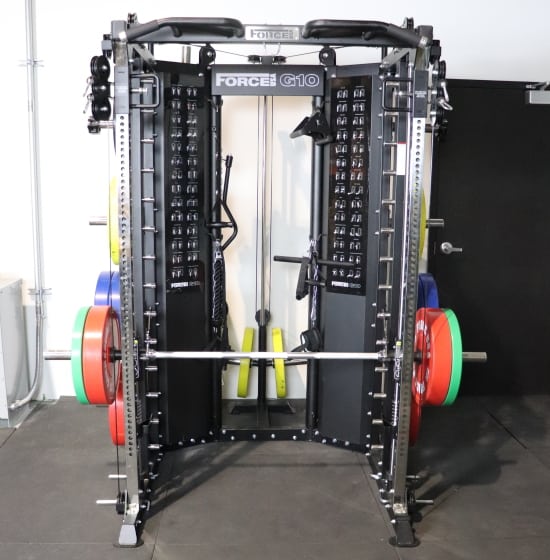
To support the G10 base unit, Force USA also includes:
- Storage Hooks (4)
- Storage Hangers (4)
- Barbell Storage (2)
- Weight Plate Holders (8)
- Exercise Charts (2)
- Band Pegs (4)
- Barbell Collars (10)
- Extension Chains (4)
- Carabiners (6)
Force USA G10/G15 Optional Upgrade Kit
The optional upgrade kit for the Force USA G10 increases the base unit functionality and adds three exercise stations. Transform your 8-in-1 machine into an 11-in-1 machine and get a few bonuses that make your trainer more enjoyable to use at home.
The upgrade adds three strength training exercise stations:
- Jammer Arms
- Install the jammer arms at any height on the power rack to simulate plate-loaded machine exercises like you would do on Hammer Strength machines in a commercial gym.
- Vertical Leg Press
- Install the leg press plate to the Smith machine bar to perform leg presses with a smooth motion while lying on a bench or the floor.
- Core Trainer
- Attach the rotating landmine unit to either side of the power rack for even more functionality. It also comes with a multi-grip t-bar row handle for landmine rows.
Storage add-ons make most of the footprint:
- Storage Shelves (4) provide space for storing and organizing your gear, right on your trainer.
- TV Mount eliminates the need for an additional stand or wall mount for your display.
The upgrade kit also includes these cable accessories to further mix up your routine on the all-in-one trainer:
- Ankle Cuff (1)
- Metal Stirrup Handles (2)
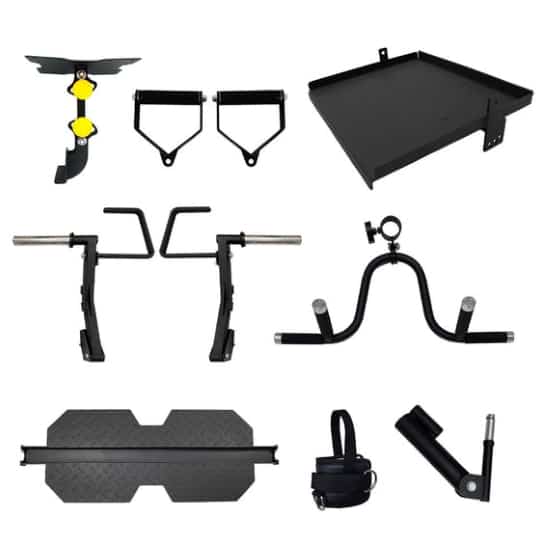
Optional Leg Curl/Extension Attachment
A leg curl/extension attachment is sold individually for $149. If you get this attachment, along with the G10 optional upgrade kit, you’ll extend the G10’s capabilities even further from an 11-in-1 machine to a 12-in-1 machine.
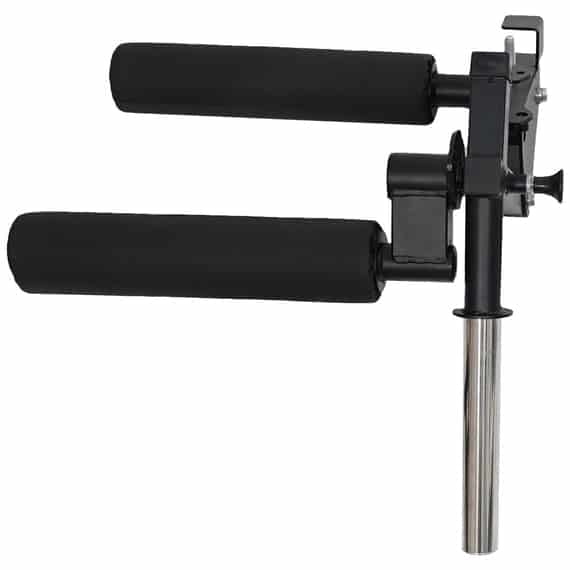
This plate-loaded leg attachment installs on the power rack and gives you the ability to do leg curls and leg extensions as well as hip thrusts.
Dimensions
When picking home gym equipment, you are usually constrained by the space you have available. Check out the Force USA G10 dimensions to make sure that you’ve got enough room for the unit and enough space to exercise.
Force USA G10 Dimensions
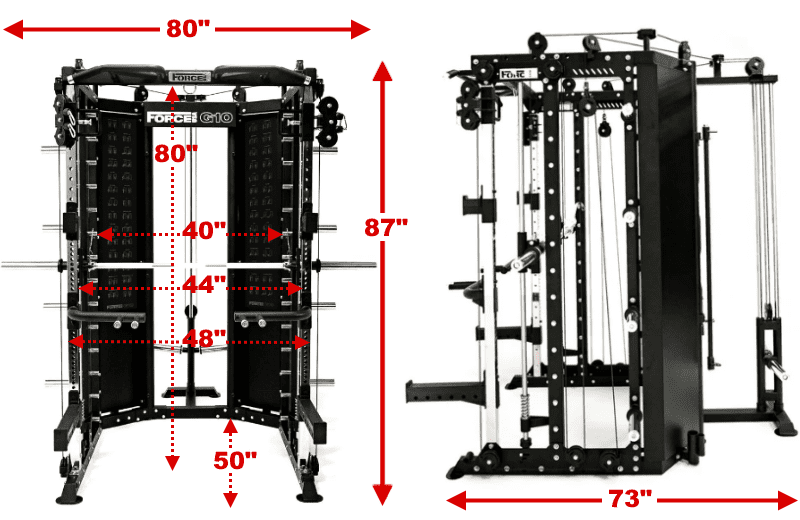
- External Height: 87″ (7’3″)
- Internal Height: 80″ (6’8″)
- External Depth: 73″ (6’1″)
- Internal Depth: 50″ (4’2″)
- External Width (Smith Machine bar length): 80″ (6’8″)
- Internal Width (Smith Machine Area): 40″ (3’4″)
- External Width (Outside Uprights): 48″ (4’0″)
- Internal Width (Between Uprights): 44″ (3’8″)
- Unit Weight: 650 lbs
Minimum Space Needed for Practical Use
Knowing the size of the unit is only half the story. After all, what good is the gym if you don’t have room to use it?
When evaluating your space, remember you need room to:
- Use the machine safely
- Add and remove Olympic weight plates
So, in addition to unit dimensions, add the following clearance space to get the most from your trainer:
- 1 foot on each side of the free weight barbell. Because the average barbell is 86.5” (7’2.5”) long, you need a space that’s a minimum of 110.5” (9’2.5”) wide.
- You can do virtually all power rack and cable exercises within 5 feet of the front of the trainer. This includes low rows using the footplate attachment. For landmine exercise, you need more like 7 or 8 feet in front of the trainer.
- To fit the weights on the plate-loaded carriage of the G10, you need an extra 6” clearance from the back.
- The ceiling height should be no less than 7’8”. This gives you 5” more than the total unit height. It provides approximately 10-12” room above the top of the chin up bar, which is needed to do chin ups without bumping your head.
Force USA G10 Review: Features
For this section of the Force USA G10 review, I’ll go over each major feature in detail and call out the benefits.
Space-Saving Design
The Force USA G10 All-In-One Trainer is by no means a small piece of equipment. But when you realize how many exercise stations are included, you’ll be amazed at how they managed to pack so much into such a space-saving design.
The Force USA G10 has a plate-loaded weight carriage on the back, so it takes up a bit more space than its more compact counterpart, the G15. Still, you get everything in about the same footprint as a deep 6-post power rack (e.g. the Rogue RML-690 6-post rack has an 80″ x 53″ footprint).
But the G10 packs in way more utility than a dedicated power rack with a similar footprint.
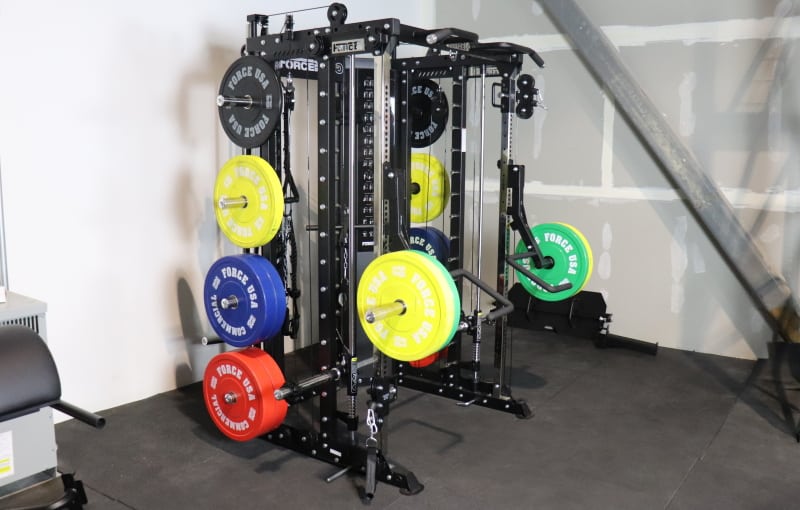
Buy the Force USA G10 – Use KING5 for 5% OFF »
It’s that space-efficient design that makes this all-in-one trainer popular with home gym enthusiasts. If you’ve got limited space but don’t want to be limited by your equipment’s capabilities, the Force USA G10 is perfect for you.
Of course, using the Force USA G10 isn’t the same as using a dedicated piece of equipment for each exercise station as you do at the local commercial gym. Here are the types of inefficiencies you’ll experience:
- Moving from one exercise to another requires a bit of setup time for the transition. It’s not a big deal, but you will spend time installing or uninstalling some of the attachments. Of course, at the commercial gym, you may spend the same amount of time just waiting to get to the equipment.
- You may find positioning yourself for some exercises a bit harder. For example, with the G10 you must position yourself under the bar of the leg press station while laying on a bench or the floor. At the commercial gym, you would just lay down on the 45-degree leg press machine and get to work.
- Certain exercises may leave you short on room. For example, when performing a seated incline press on the Smith machine (especially at the high incline settings), you may find that fitting an adjustable bench in the upright position so you face out of the rack isn’t going to work. To get enough room to work, you’ll need to turn the bench so you face the back of the rack. Awkward but doable. It just takes getting used to it.
These downsides are worth it for most people considering buying the G10. The G10 packs a ton of features into its compact design – and that’s what’s important for most people in the market for an all-in-one trainer.
Cost-Saving Design
The Force USA G10 All-In-One Trainer uses space sparingly and is (relatively) kind to your wallet as well.
Of course, the trainer isn’t cheap, with a price tag of $2,999. But it does save you money.
That’s because it replaces many different machines. You get a whole lot of value for the price you pay.
Just consider what it would cost to buy each exercise station separately.

Even buying the individual machines used is going to take considerable time and money. You’ve got to shop around sites like Facebook Marketplace, OfferUp and Craigslist, which will eat up your valuable time, and then you’ve still got to negotiate price and delivery or pickup.
Versatile Design
The Force USA G10 All-In-One trainer is designed with versatility in mind. You enjoy a ton of training capabilities in a compact footprint.
The base unit provides 8 exercise stations that support hundreds of different exercises. You’ll be amazed at the variety you have available.
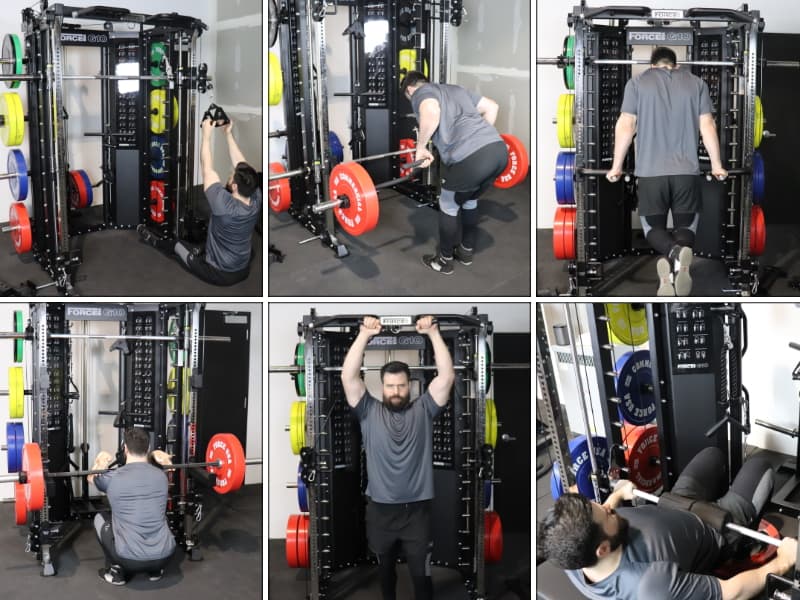
When you add on the upgrade kit, you get an additional 3 exercise stations with even more exercise possibilities, the coolest of which is the jammer arm movements.
The Force USA G10 base unit is an incredibly versatile 8-in-1 machine. The upgrade kit kicks the utility up to an 11-in-1 machine.
When you compare the number of exercise stations in the G10 base unit to other trainers in the G-Series, you’ll see it offers fewer exercise stations than many of the others. But add on the optional upgrade kit and you’ll get more exercise stations than any other model aside from the G20.
Here is how the other G-Series units compare to the G10 in terms of exercise stations:
- G3: The base model is a 5-in-1 machine and you can upgrade it to a 7-in-1 machine with optional attachments (sold individually, not in a kit).
- G6: A 9-in-1 model with no upgrades.
- G9: The base unit is a 10-in-1 machine and no upgrades are available.
- G12: Like the G6, this is a 9-in-1 machine with no upgrades.
- G15: Like the G10, this is an 8-in-1 machine that upgrades to an 11-in-1.
- G20: This top-of-the-line model comes with an 11-in-1 machine as the base unit that can be upgraded to a 14-in-1 machine.
The Force USA G10 provides incredible versatility because of the optional jammer arms. The G15 is the only other model in the G-Series that offers optional jammer arms. Force USA says they will have a jammer arm option for the G20 sometime in the future. But they don’t yet have a set date for “the future”. The addition of jammer arms to the G20 will make it slightly more versatile than the G10 or G15. Whenever that happens.
Exercise Capabilities
The most important function of any trainer is the exercises it supports. The following is an overview of the Force USA G10’s exercise capabilities:
- The power rack, which is really a half rack, gives you access to more than 40 barbell movements. You can perform practically every free weight barbell exercise that you perform with a full-sized dedicated power rack.
- The functional trainer gives you access to more than 75 cable exercises. It supports any cable movement you can imagine through any plane of motion. This is made possible by the 22 height settings for each adjustable pulley, and the several included cable attachments.
- You can turn the functional trainer into a lat pulldown machine by using the lat pulldown leg holder to hold your legs while you sit on the floor or on a bench.
- You can use the functional trainer with the included footplate attachment to perform cable low rows.
- The Smith machine station is a fixed-track barbell that gives you the ability to perform 30+ Smith machine exercises. This station supports a version of most free-weight barbell exercises in addition to exercises that you can only do on a Smith machine.
- The multi-grip chin up station gives you access to at least 12 chin up variations. The chin up bar includes straight, perpendicular and angled segments, to support 4 different grip positions (pronated, supinated, semi-supinated, neutral) and 3 grip widths (narrow, medium and wide).
- Use the dip station for several dip variations, including wide grip dips and close grip dips. And that’s just the beginning. With a little creativity, you can perform several more dip variations on the dip station.
- The suspension trainer rings give you access to around 80 suspension trainer exercises when you attach a suspension trainer unit (sold separately). You can also attach a resistance band or even a heavy bag here as well.
The optional upgrade kit for the G10 adds 3 more exercise stations that unlock these additional exercise capabilities:
- Jammer arm attachments allow you to perform almost any exercise you can do on plate-loaded lever-style machines (e.g. Hammer Strength machines) like those in commercial gyms. This adds more than 20 jammer arm exercises to the unit’s functionality.
- Leg presses are highly effective in building up your leg and glute muscles. The vertical leg press station offers 3 leg press variations: narrow, medium and wide stance.
- The landmine attachment adds another 30+ landmine exercises to this all-in-one gym. These exercises are important in training the shoulders and increasing core stability. In addition, you can perform some powerful landmine row variations.
Build Quality & Warranty
The Force USA G10 All-In-One Trainer is a heavy-duty unit that features thick, 11-gauge steel on the power rack uprights with a 992 lb (450 kg) weight capacity rating. The unit is strong enough for essentially any lifter.
Aside from the G10, only the G20 features 11-gauge uprights. Every other G-Series unit is built with slightly thinner 12-gauge uprights.
The G10 weighs a hefty 650 lbs so you don’t have to worry about the unit moving during use, especially when you have your weight plates stored on it.
It is built well for home gym use. But it is not built to handle use in a high-traffic commercial gym. In any case, large commercial gyms are packed with specialized equipment so there would be no need for an all-in-one trainer in the first place.
There are a few niche commercial applications where the G10 can shine:
- Personal training studio
- Physical therapy office
- Low-traffic community gyms
- Boxing/MMA gyms with a small resistance training area
- Office/corporate gyms
- Hotel/apartment complex gyms
The G20, G12 and G9 will also work well in these situations. However, the G10 or the G15 is the better choice for these scenarios. Their interchangeable pulley ratios make them a good fit for newbie use.
Beginner lifters will appreciate the 4:1 ratio that allows them to work with extra light weight and progress in small increments.
The Force USA G10 comes with the same lifetime structural warranty as the other G-Series models. The warranty covers the frame components and the assembly hardware used. This warranty covers any failures in the structural portion from normal use.
The cables and pulleys fall under a 2-year warranty and all rack accessories are covered by 90-day wear and tear warranty.
Power Rack
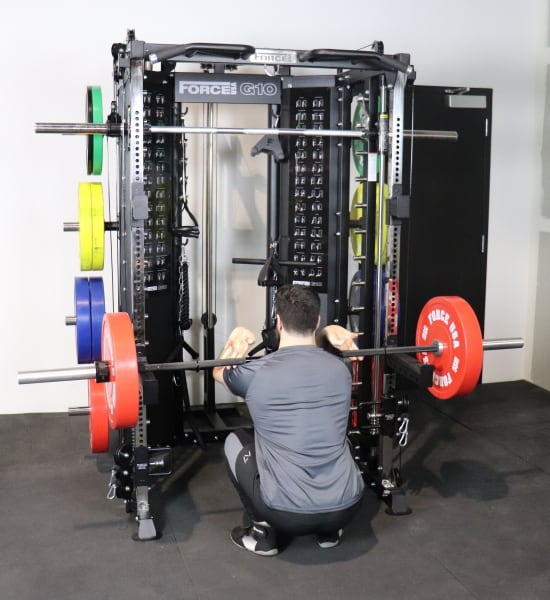
Buy the Force USA G10 – Use KING5 for 5% OFF »
The power rack on the G10 is really a half rack. It has 2 uprights instead of 4 and the cage isn’t fully enclosed. But Force USA calls it a power rack, so to avoid confusion in this Force USA G10 review, I’ll do the same.
Half racks and power racks provide the same exercise capabilities. You can use either for safely lifting barbells.
A true power rack is fully enclosed, so it offers a bit more safety. But a half rack has a much smaller footprint, which is key for an all-in-one gym.
There are dozens of barbell exercises you can do on the Force USA G10 power rack station. Here is a partial list:
- Front Squat
- High Bar Squat
- Low Bar Squat
- Box Squat
- Lunge
- Split Squat
- Bench Press
- Incline Bench Press
- Decline Bench Press
- Close Grip Bench Press
- JM Press
- Standing Shoulder Press
- Seated Shoulder Press
- Z-Press
- Push Press
- Rack Pull
- Stiff Leg Deadlift
- Romanian Deadlift
- Good Morning
- Barbell Row
- Shrug
- Power Shrug
- Curl
- Upright Row
- Cuban Press
These exercises require a barbell and weight plates, which are not included. You’ll also need a flat or adjustable weight bench for some exercises and that isn’t included either. Be sure to budget for these items if you don’t own them.
Now that you understand the functionality of the G10 power rack, let’s look at key specifications and dimensions.
To start with, understand that the G10 power rack will provide all the capacity you should need. It is rated for 992 lbs, which is a strange number until you realize that’s what you get when you convert 450 kilograms to pounds. That’s almost an exact match for the 1000 lb capacity industry-standard rating for a non-budget rack.
The G10 uprights are the same ones used on the G15 and G20 models. The uprights measure 2”x2” and are made with 11-gauge steel.
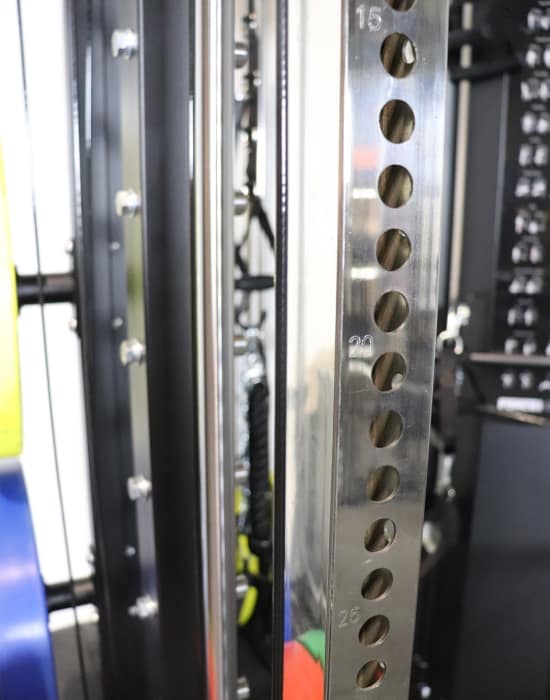
The uprights on the G3, G6, G9 and G12 are the same size but are made with thinner 12-gauge steel.
The actual weight capacity of the G10 is probably higher than the 992 lbs it is rated. The G3, G6, G9 and G12 all carry the same capacity rating but their uprights are made from thinner steel. Go figure. It doesn’t matter because unless you become an elite powerlifter, this rack can handle whatever you throw at it.
The Force USA G10 power rack sports an internal width of 44″. This is the space between the inner surfaces of the 2 power rack uprights. For comparison purposes, most dedicated power racks have an internal width of 41” to 44”.
Sufficient internal width is vital to providing the space you need to do barbell exercises smoothly and safely. If you don’t have enough room it’s easy to pinch your fingers when re-racking the bar. You don’t need to worry about that with the G10.
The G10 has the same 44″ internal width as the G15 and the G3. It’s half an inch narrower than the G20’s 44.5” width. The G6 is notably narrower at 41”, while the G9 and G12 give you a wider 48” internal width.
The Force USA G10 has a 48” external width measurement. This is the distance between the outer surface of the power rack uprights.
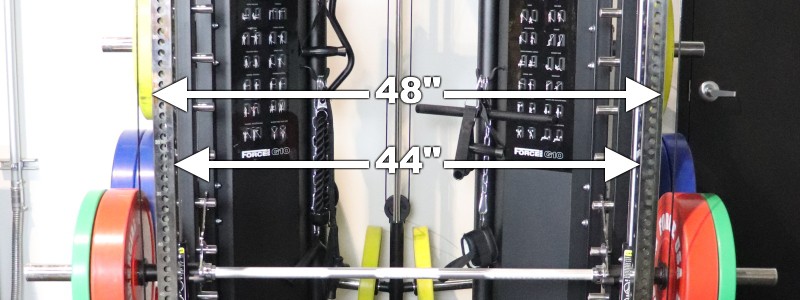
Most dedicated power racks on the market have an external width measurement between 47-49”. So the G10 is totally acceptable.
Too much external width makes it hard to rack and unrack your barbell. You can accidentally bump your barbell sleeves into the j-hooks.
The Force USA G10 has the same 48” external width as the G15 and G3. It’s just a half-inch narrower than the G20, which is 48.5” wide. The G6 has a narrower 45” external width. The G9 and G12 both have a super-wide external width of 52”. But their j-hooks and spotter arms are indented 1.5” on each side, which makes the internal width 49” for practical purposes.
The Force USA G10 power rack includes a pair of j-hooks for racking and unracking the bar for all types of barbell movements.
It also includes a set of safety spotter arms. They catch the barbell in case you fail at the bottom of a rep or drop the barbell for any reason. This safety feature is a must-have to ensure you don’t get stuck under the bar when performing movements with heavy weights.
The final standard power rack attachment is the dip station. It includes 2 separate handles to install on the uprights to perform dips.
Now that you know about the power rack itself, let’s go over hole spacing, j-hooks and spotter arms in greater detail.
Uniform 1-Inch Hole Spacing
The Force USA G10 All-In-One Trainer has uniform 1-inch hole spacing. I like to call this non-traditional Westside hole spacing.
To understand what this is, let me first define traditional Westside hole spacing – Holes on the uprights have a ⅝” diameter and are spaced 1” and 2” apart:
- The 1” hole spacing occurs in the middle area of the uprights to provide more precise positioning for movements like the bench press, where an inch is the difference between an acceptable and an ideal position for the j-hooks and spotter arms.
- The 2” hole spacing occurs above and below the 1” hole areas. The thinking is precision positioning isn’t so important here. 2” hole spacing at the top provides enough accuracy to set the j-hooks at the right height to rack and unrack the bar for squats.
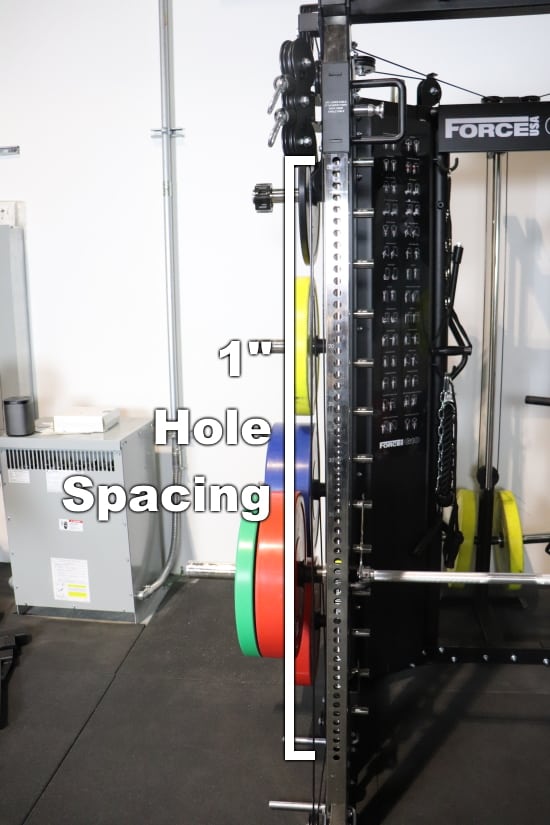
The Force USA G10 improves on Westside hole spacing by providing ⅝” holes spaced 1” apart, period.
Forget the 2” hole spacing. Instead, you enjoy extremely precise hole spacing on the entire height of the uprights.
For comparison sake:
- The G15 and G20 both use the same non-traditional Westside spacing (uniform 1″ spacing) as the G10.
- The Force USA G3 also has non-traditional Westside hole spacing but in a different way. Its power rack uses 2” spacing in the upper area only and 1” spacing in the middle and lower regions.
- The G6, G9 and G12 have uniform 3.75” hole spacing. That works for general-purpose strength training. But if powerlifting-style training is your style, you’ll want the greater precision provided by Westside hole spacing.
The G10 power rack has 60 holes per upright, which is more than all other G-Series models besides the G20 and G15. In comparison:
- The G15 also has 60 holes
- The G20 has 65 holes
- The G3 has 50 holes
- The G6, G9 and G12 all have 16 holes
You’re able to install the j-hooks on all of the holes on the G10. Same for the G6, G15 and G20.
However, you can’t use j-hooks in every hole on the G3, G9 and G12. With these units, the pulleys must be above the j-hooks otherwise the cable will be in the way. Putting the pulleys in the highest position blocks the uppermost power rack holes.
Tall lifters will like that the uppermost holes are accessible on the G10.
J-Hooks
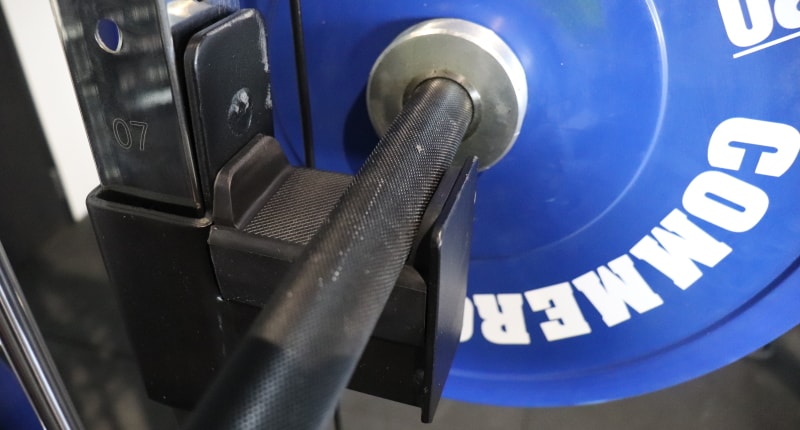
The Force USA G10 power rack includes a pair of j-hooks for racking and unracking your barbell when performing squats, benches and other movements.
It is the same basic J-hook design as the G6, G9, G12 and G15 j-hooks.
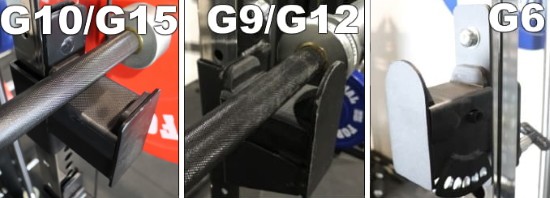
As I’ve said in my other G-Series reviews, I don’t think this is the best J-hook design.
On the lower surface, there’s a removable protective rubber insert that pops out. I think instead of rubber, they should use UHMW plastic and it should be permanently attached.
The back of the J-hook is short. I think the back should be taller and have a UHMW insert. You would avoid metal-on-metal contact from your barbell and uprights.
But that doesn’t mean the J-hook design doesn’t work. It still does the job of safely holding a heavy barbell when racking or unracking just fine.
I believe that the G3 and G20 have a superior J-hook design.
The j-hooks on the G3 have permanently affixed protective inserts on the back and the bottom surfaces. Though, the back could still be taller.
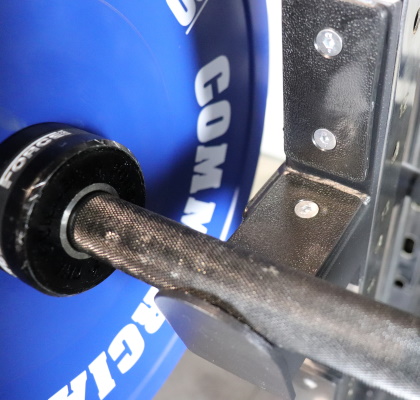
I like the G20 J-hook design best. Because it’s a roller J-hook, you can center your barbell effortlessly. The 7” back portion is plenty tall and I like the permanently affixed protective insert.
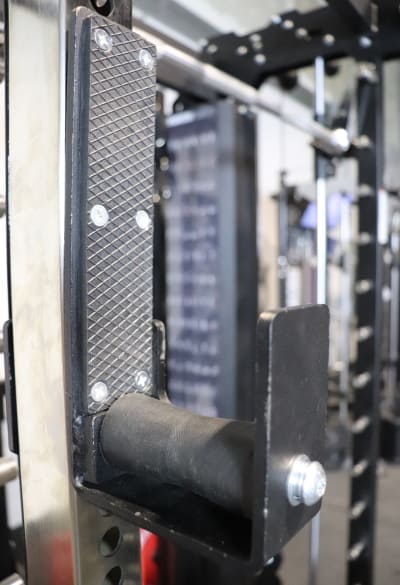
From the floor to the highest J-hook setting where the barbell sits is 70” (5’10″). You could be 7’0” tall and still be able to squat comfortably. Of course, your head would hit the top of the rack if you were that tall, but the point is that 6-foot-something tall lifters won’t have an issue squatting.
Even though the Force USA G10 is one of the shortest of the G-Series units, the maximum max bar height for the j-hooks is still higher than the other trainers in the G-Series. That’s because:
- The holes on the uprights go high up
- The uppermost holes are all accessible. With some of the other units, you must put the pulleys above the j-hooks, and even then they can block the top holes.
- The j-hooks are much taller on the G20, so they hang further down.
The max bar height for the j-hooks on other G-Series models is:
- G3 = 66″ (5’6″)
- G6 = 69″ (5’9″)
- G9 = 60″ (5’0″)
- G12 = 60″ (5’0″)
- G15 = 70″ (5’ 10”)
- G20 = 67″ (5’7″)
The G9 and G12 provide the shortest max barbell height. But you can be as tall as 6’4”-6’5” and still squat with on those models. If you are just a bit taller than that, any of the other units will work. However, if you are 6’5”+, the height of the G20 is better for exercises inside the unit as well as for pull up.
Spotter Arms
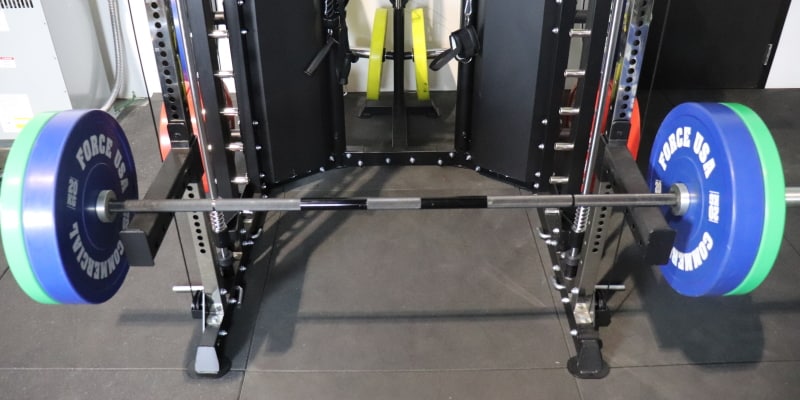
The Force USA G10 power rack comes with a pair of safety spotter arms. These are critical safety pieces for your protection in case you fail at the bottom of an exercise.
There is nothing unique or extraordinary about the G10 spotter arms.
The arms are strong enough to stop a dropped barbell and protect you. That’s the most important function of spotter arms.
The length of the spotter arms is 15”. That is the same as the G20, G12, G9, G6 and G15. The G3 is the only unit with longer spotter arms. They are 17.5”.
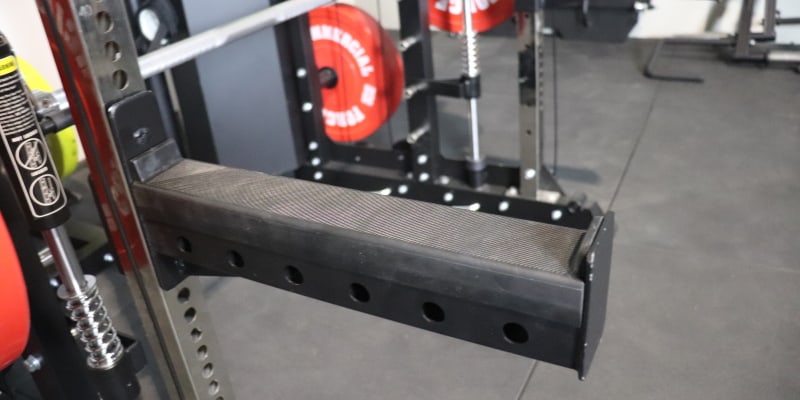
I like a longer spotter arm. Most dedicated power racks have spotter arms that are 20-24” long. That extra length comes in handy if you want to do your exercises further away from the uprights. But the 15” length still gets you over the spotter arms without being too near the uprights.
A rubber insert made from the same material as on the j-hooks protects your barbell from damage when dropping the bar or setting it down.
As I mentioned in the J-hook section, I think the protective insert should be made from UHMW plastic and permanently attached. Don’t get me wrong, the rubber is durable enough to last, I just think the UHMW offers better protection.
The G10 spotter arms have band peg holes that are convenient if you are the type to get creative with your exercises.
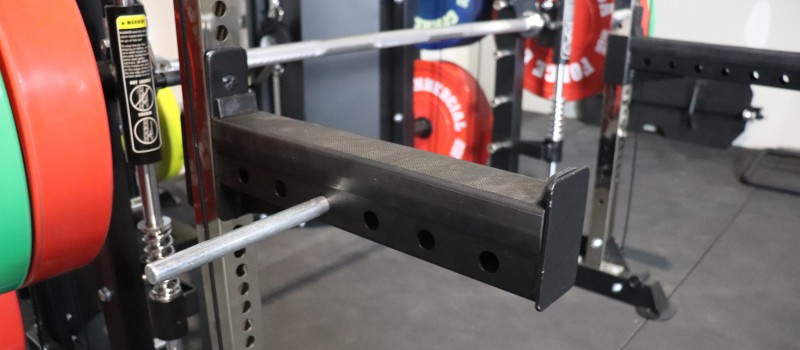
For example, if you wanted to do lat pulldowns in the center of the functional trainer, you could just put band pegs in the holes and to connect a resistance band across the spotter arms to act as a leg holder.
The G3, G15 and G20 also have band peg holes in the spotter arms. The other units do not.
The shortest possible spotter arm height is 12” from the floor to where the barbell sits. This is just a little more distance than you would have if you were on the floor with a barbell fitted with 45 lb plates.
This low spotter arm height is useful for low rack pulls. Don’t forget, if you want to do progressively higher rack pulls you can always raise the spotter arm height in 1-inch increments.
Included Barbell Collars
The Force USA G10 includes 3 pairs of plastic Olympic lock collars and 2 pairs of metal Olympic spring collars. Collars keep your plates secure during barbell exercises and you generally don’t want to lift without them.
I like plastic Olympic lock collars because they are easier to put on the bar and stay there securely.
The metal spring collars are acceptable but they are prone to warping and lose their ability to stay on tightly over time.
Functional Trainer
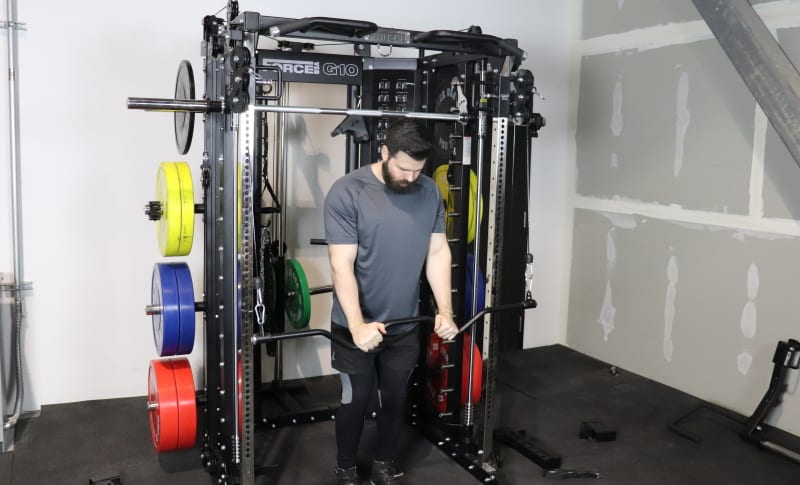
Buy the Force USA G10 – Use KING5 for 5% OFF »
The functional trainer is the heart of the Force USA G10 All-In-One Trainer.
Each upright on the functional trainer includes an adjustable height pulley trolley. The power rack uses these same uprights. Holes for the functional trainer settings are located on the inside of the uprights.
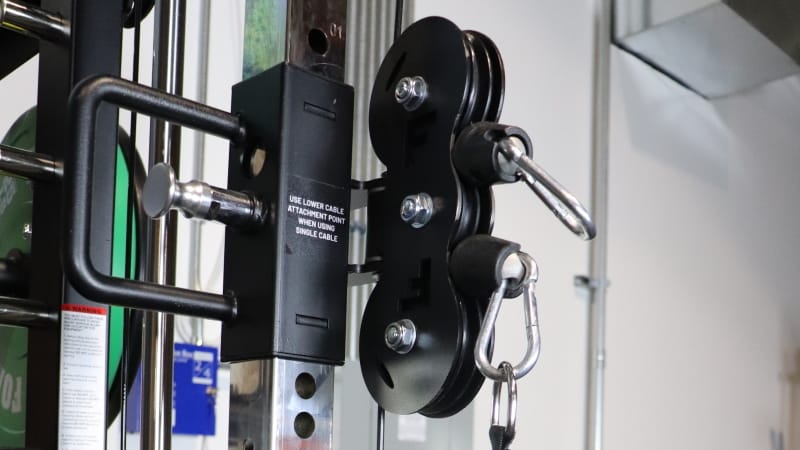
The G10 offers 22 pulley height settings. The G3 and the G15 are the only other units that offer 22 height settings. The other G-Series trainers offer fewer height settings. That’s pretty remarkable considering the G10 is shorter than the G6 and G20.
Force USA achieves this by spacing the height settings a mere 3” apart. This is much closer than the spacing on the other units.
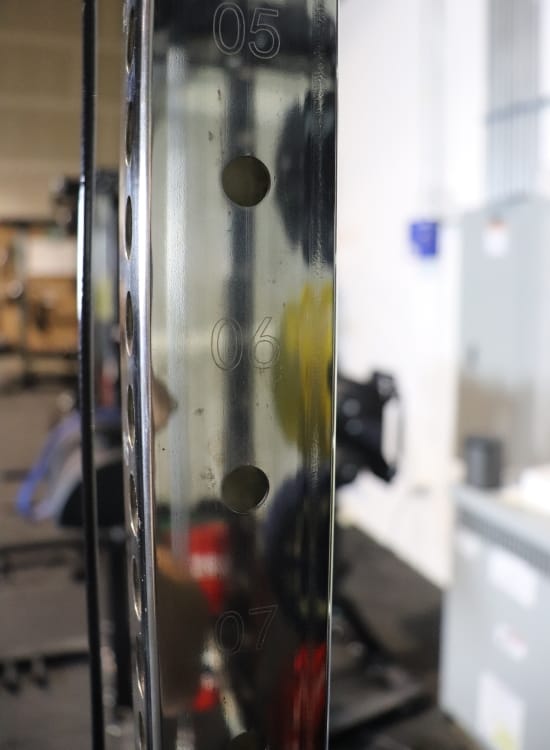
The G20 and G6 provide 19 height settings and the G12 and G9 offer 16 settings.
The Force USA G10 offers an interchangeable 2:1 and 4:1 pulley ratio. This feature is unique to the G10 and G15 models.
The pulley ratio of a cable machine refers to the ratio of the weight loaded to the amount of resistance you feel during exercise.
If you set the pulley ratio to 2:1 and load 100 lbs on a weight stack, you’ll feel 50 lbs of resistance. If you set the ratio to 4:1, you would feel 25 lbs of resistance.
The G10 interchangeable pulley ratio allows you to seamlessly change between a 2:1 and 4:1 ratio to match your need for heavier or lighter total weight or larger or smaller increments.
Force USA has a patent pending for this design. It’s not something you will find in any other functional trainer sold.
The design is ingenious:
- Two sets of cables connect the weight to the pulley trolley on each side of the functional trainer.
- The pulley trolley has 2 separate cables with 3 pulley wheels that separate them.
Compare this to the traditional setup where the pulley trolleys have 1 cable coming out with 2 pulley wheels.
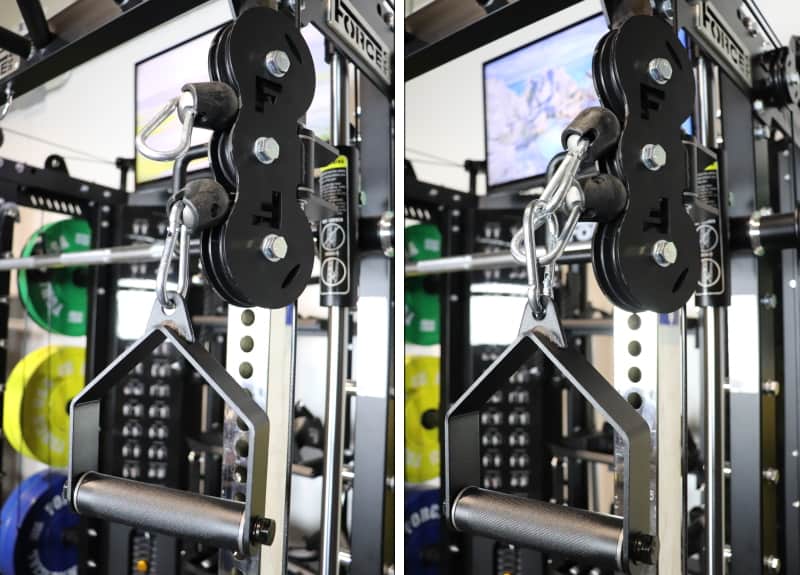
On its own, each cable has a 4:1 ratio. But by connecting an attachment to both cables, you convert the ratio to 2:1.
I like the design, I like how it works and I really like the additional utility it offers.
However, I did notice a few things:
- When you’re moving the cable downwards (like during a triceps pushdown) using the 4:1 ratio, you must attach the cable attachment to the lower pulley cable. Likewise, you need to attach to the upper clip when you perform movements where the cable moves upwards (like during a cable curl). If you don’t do this, the cable in use rubs against the cable that’s not in use.
- For the 2:1 ratio, it can be a hassle to connect your attachment directly to the 2 built-in cable carabiners. The easy fix is to simply attach your attachment using a third carabiner that affixes to the built-in carabiners.
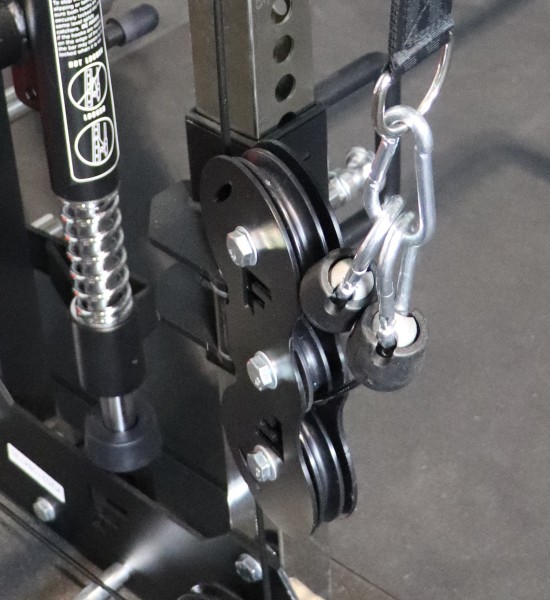
This revolutionary design is in response to user requests for smaller weight increments. The interchangeable ratio works well in home gyms where the unit is shared with women or children who might not be as strong.
Even if you’re the sole user and relatively strong, you’ll find the 4:1 ratio useful for smaller incremental progress on isolation exercises.
Also, it makes doing drop sets a cinch. You can instantly halve the weight on this plate-loaded machine by simply switching from the 2:1 ratio to the 4:1 ratio. There’s no need to stop, go to the plate-loaded weight carriage and remove half the weights.
As you can see, this is a marked improvement over the pulley ratios offered by other G-Series units:
- G3: 2:1 ratio
- G6: 2:1 ratio
- G9: 2:1 when using one side at a time; 1:1 ratio when using both sides together (get the full explanation here)
- G15: 2:1 and 4:1 (same as the G10)
- G12: 1:1 ratio
- G20: 1:1 ratio
Because the G10 is a plate-loaded system, you must manually add weight plates to weight pegs on a carriage.
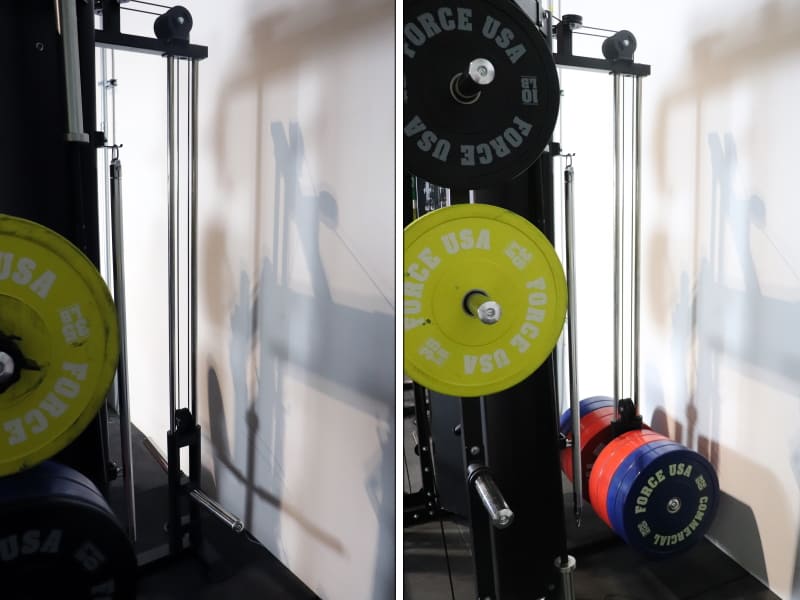
Right: Plate-loaded weight carriage with weight added.
It makes for a less expensive machine than a selectorized system like the G15, but it also makes changing weight less convenient. The dual ratio solves part of this problem.
On the plus side, you can potentially load a ton more weight than on a selectorized unit. The weight pegs are 12″ long on the plate-loaded weight carriage.
If you have regular cast iron Olympic weight plates, you could fit eight 45 lb plates per side, since each one is just 1.5″ thick. That’s a total of 720 lbs, which translates to 360 lbs of resistance when using the 2:1 ratio.
Unless you’re an absolute freak, good luck ever needing anything close to that much weight for any cable exercise.
Of course, if you have thicker weight plates, especially bumper plates, your max weight will be less. I was able to fit two 55 lb bumper plates and two 45 lb bumper plates per side, which is 400 lbs total and 200 lbs with the 2:1 ratio.
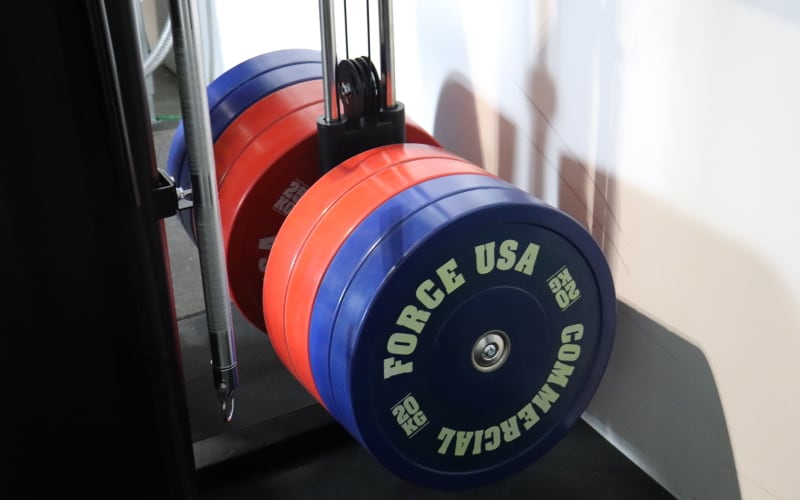
The G10 and the G15 are almost identical. For most people deciding between the G10 and G15, the two most important factors to consider are the value placed on:
- The ability to quickly adjust weight
- Budget
The G10 is a massive $2,500 less expensive than the G15. However, the trade-off is that the weight change process is not nearly as efficient.
They say time is money, so for some lifters, the G15’s quick-change system may be worth the additional cost. But if you’re on a budget, the G10 is the obvious choice.
I talk more about choosing between the Force USA G10 vs G15 later on.
The cable motion on the G10 is practically frictionless. The smoothness is comparable to the experience you’d find when you use cable machines in a commercial gym.
These are the minimum and maximum pulley height settings for the G10, from the floor to where the cable exits the pulley:
- Lowest setting: 10.5”
- Highest setting: 72.5”
This height range, along with the 3” height setting increments, lets you hit virtually any angle you want on cable exercises. You can go high to low, low to high, straight out and everything in between.
The cable travel distance is 60” (5’0”) with the 2:1 ratio. This doubles to 120” (10’0”) with the 4:1 ratio. These distances are fixed, whether you use one side of the functional trainer at a time or both at once.
The 2:1 ratio cable travel distance is sufficient for any regular cable exercise. The extra length on the 4:1 ratio cable distance allows for less common cable movements such as cable lunges and cable sled pulls.
Here’s how the other G-Series units stack up to the G10 in the cable travel department:
- G3: 145”
- G6: 60”
- G9: 51.5” when using both cables at once; 103” when using one cable at a time.
- G12: 53”
- G15: 60” when using 2:1; 120” when using 4:1
- G20: 106”
Cable Accessories
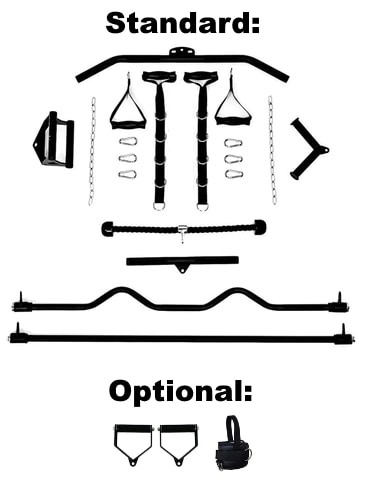
The Force USA G10 All-In-One Trainer comes with 9 standard cable accessories. You get another 2 optional cable accessories when you buy the upgrade kit.
To compare, these are the number of accessories that come with the other G-Series units:
- G3: 7 cable accessories
- G6: 9 cable accessories
- G9: 5 cable accessories
- G3: 5 cable accessories
- G3: 7 cable accessories
- G15: 11 cable accessories (9 come standard, 2 are optional)
- G20: 11 cable accessories
The G10 cable attachments include the following:
EZ Curl Bar
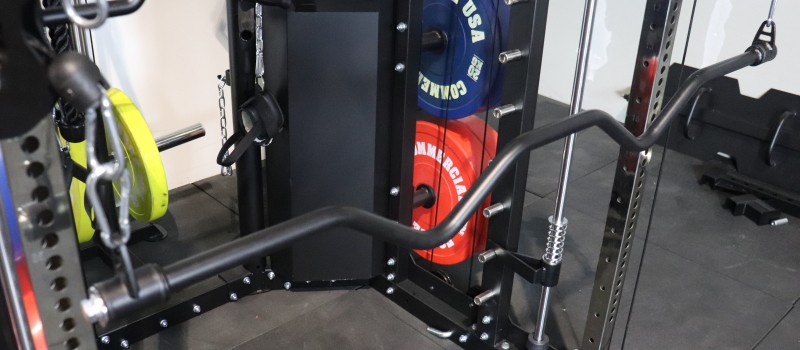
The EZ curl bar attachment is a dual cable attachment that is almost the same as the attachment included with the G3. It attaches to both sides of the functional trainer simultaneously and is black, slender and lightweight.
But unlike the EZ curl bar on the G3, the G10 curl bar is smooth. Some knurling on the G10 version would be nice to improve the grip. But at least its powder coating provides some amount of grip.
The bar rotates freely on its axis. This provides a smooth motion on the curls and triceps extensions commonly performed with this piece. You can also use the EZ curl bar for upright rows and other row variations.
All-in-all, I like the feel and function of this attachment.
Long Straight Bar

Bottom: This is a different version I used when reviewing the G10.
Take the EZ curl bar, straighten it out and you’ve got the long straight bar. It’s a black slender bar that rotates on its axis and attaches to both sides of the functional trainer.
Unlike the long straight bar that comes with G3, this one does not have a center hook enabling it to be hung on a single pulley.
I like this attachment for press moves, such as the standing chest press and standing shoulder press. My favorite movement with the long straight bar is the jackhammer pushdown. With this move, you lean your torso over the top of the bar and push down. It’s a great way to get the same effect as performing dips. It really works the lower chest.
You could use this bar for lat pulldowns or rows in the center of the machine.
Short Straight Bar
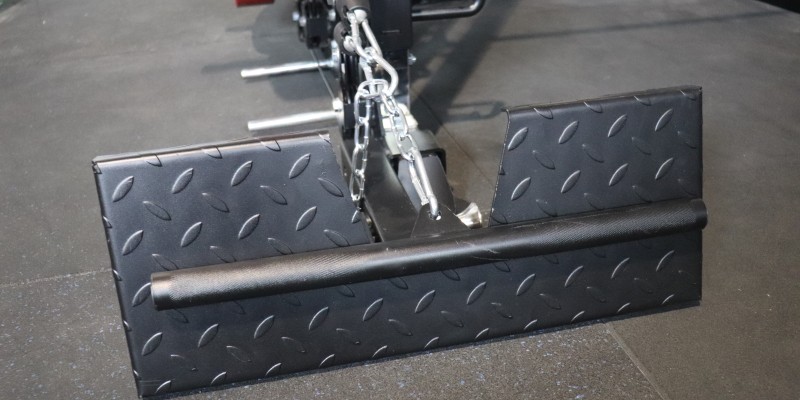
The short straight bar works for cable curls, triceps pushdowns, close grip pulldowns, forearm curls and other similar movements.
The short straight bar that comes with the G10 is identical to the attachment provided with the G20. Both are short and feature a knurled, black powder-coated surface.
This is a superior design to the short bar that comes with the G3, which features no knurling.
The G6 also has a short straight bar. However, it has rubberized grips instead of knurling. The G6 version is better than the G10 version because the bar rotates.
Since the G10 short straight bar lacks rotation, many movements feel less natural or smooth.
The G9 and G12 do not include a short straight bar attachment.
Lat Pulldown Bar
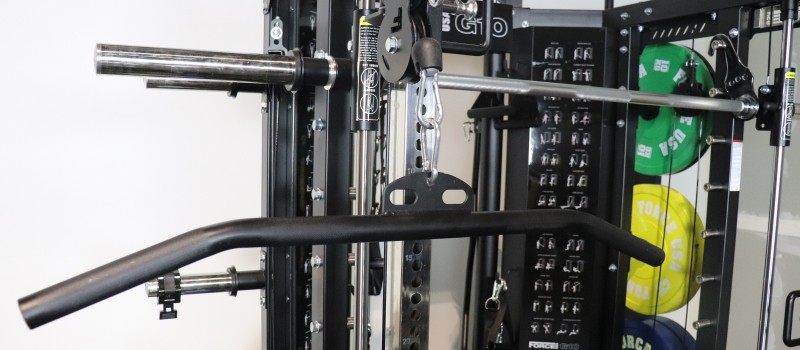
The lat pulldown bar features a black powder coating and light knurling. Like most lat pulldown bars, the ends are angled down to provide a natural wrist position when using a wide grip.
The G20 includes the same lat pulldown bar.
Because this lat pulldown bar offers knurling instead of rubberized grips, I like it better than the ones that come with the G12, G9 and G6. Still, I wish Force USA had gone more aggressive with the knurling.
The lat pulldown bar is the obvious attachment for doing lat pulldowns using a wide grip, medium grip or supinated grip. When it comes to close grip pulldowns, I ditch this attachment and use the close grip row handle.
This attachment is also great for performing wide grip rows, medium grip rows (supinated or pronated) and straight arm pulldowns.
Triceps V-Bar
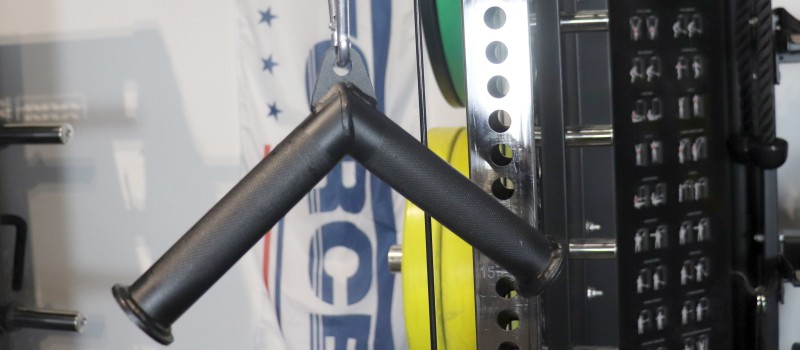
The triceps v-bar sports a black powder coating and light knurling.
This attachment is perfect for triceps pushdowns but doesn’t do much else.
The G15 and G20 offer the same attachment. Only the G6 also offers a triceps v-bar, which uses rubberized grips instead of knurling.
Close Grip Row Handle
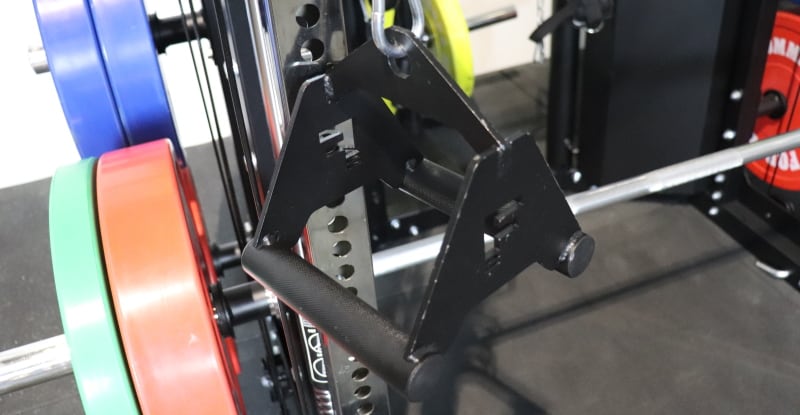
The close grip row handle is your go-to attachment for close grip rows and close grip lat pulldowns. I like the way it feels during these movements. It places your hands in a narrow, neutral grip position.
The frame has the Force USA “F” laser cut into both sides for a nice branding touch.
I do wish it was made with a deeper knurl pattern. But, the light knurling works well for all but the heaviest sets. The grip quality gets a little boost from the black powder coating.
The G15 and G20 come with the same close grip handle as the G10.
I like this handle better than the G3 close grip handles that come with the G3 and G6. The G3 version is chrome and knurled and the G6 version is also chrome but features rubberized grips.
You won’t get this attachment with the G9 or the G12.
Triceps Rope
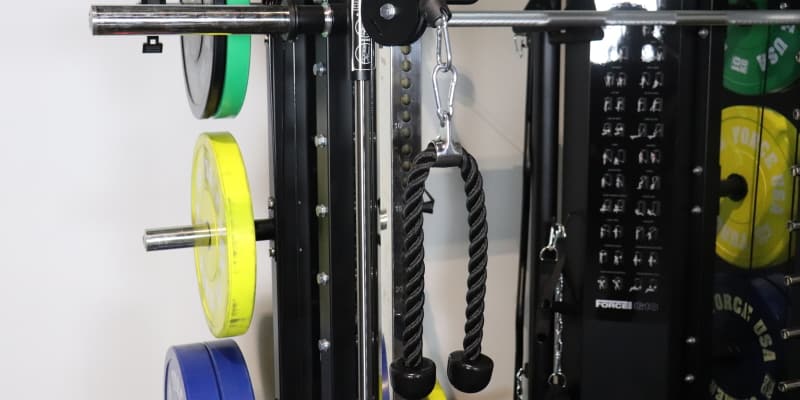
You know the standard black, double-ended triceps rope you use at the local gym? This is the same thing. It’s also the same triceps ropes you get with the other G-Series units.
But just because it is common, doesn’t mean it’s not necessary. You’ve got to have this for triceps extensions, hammer curls, face pulls, pull-throughs, lying pullovers, crunches and so on.
Nylon Stirrup Handles (2)
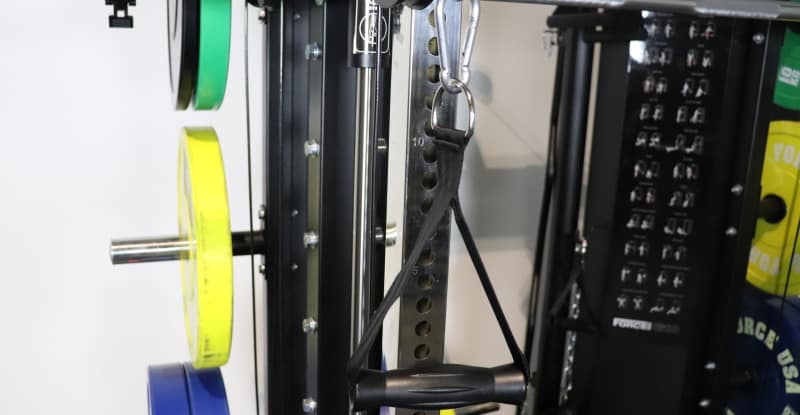
These nylon stirrup handles (aka D-handles) have a hollow plastic handle over fabric straps. They may be basic, but they are useful in many ways.
The hollow handle over the fabric gives you the flexibility to adjust your wrist orientation to the most natural position for your motion.
There’s no chafing when the fabric rubs against or presses your forearm either.
The G20 and the G15 come with the same nylon stirrup handles. The G9 stirrup handles are nearly the same except the grips are foam-padded. The handles on the G6 are metal, so they aren’t as versatile. The G3 and G12 only offer an adjustable-length version of these D-handles.
This attachment is perfect for cable exercises such as crossovers, chest press, shoulder press, lateral raises, bent-over lateral raises, single-arm row variations and other similar movements.
Adjustable Nylon Stirrup Handles (2)
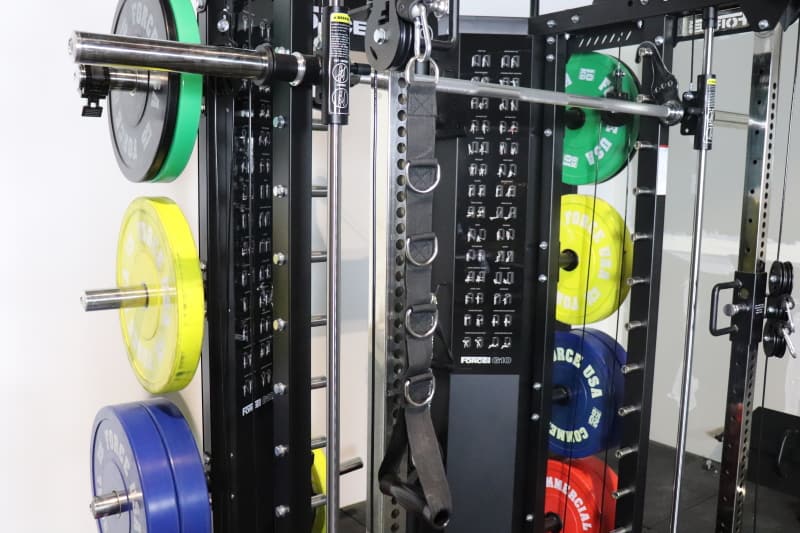
These adjustable nylon stirrup handles are the same as the regular nylon stirrup handles (discussed above) except they have a long strap that lets you adjust the length.
The length is adjusted by choosing one of the 5 metal rings on the extended strap. This allows you to attach the stirrup handles at a comfortable distance from the pulley.
This attachment comes in handy if you want to begin an exercise further out from the uprights.
This is the same cable attachment that comes with the G12, G15, G20 and G3 trainers.
Metal Stirrup Handles (Optional)
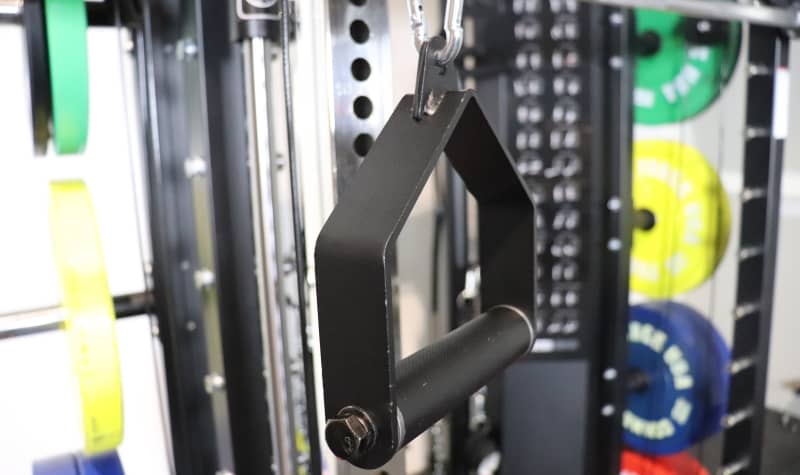
If you purchase the optional upgrade kit, metal stirrup handles are included.
These handles are made with a solid steel frame and a lightly knurled steel grip. Black powder coating adds a bit more grip. The grip rotates within the handle.
This attachment is great for any exercise where you need a D-handle attachment but no flexibility.
This is not the attachment for cable crossovers. As you bring your hands together the metal will press into your forearms and bring new meaning to “no pain no gain”. Except there’s no gain – just pain.
I like these stirrup handles for cable exercises like one-arm rows, single-arm concentration curls, single-arm lat pulldowns and bilateral lat pulldowns that are performed between the 2 cable columns.
These same handles are also available optionally for the G15. The G20 includes this attachment standard. The G6 comes with a chrome variation that includes a rubberized grip.
Ankle Cuff (1) (Optional)
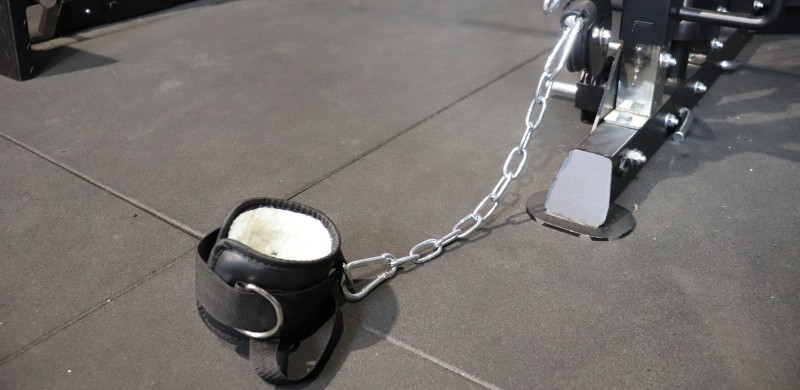
The ankle cuff attachment comes with the optional upgrade kit.
This ankle cuff doesn’t just wrap around your ankle. It has a nylon fabric loop that goes under your foot. This is a big upgrade from the standard configuration as it keeps the cuff from sliding up your ankle, which is not pleasant.
In addition, a padded inner lining on the cuff provides a comfortable fit.
You can use this attachment for cable exercises like hip abductions/adductions/extensions/flexions and donkey kicks.
Aside from the G10, only the G15 offers this optional ankle cuff attachment.
Carabiners (6)
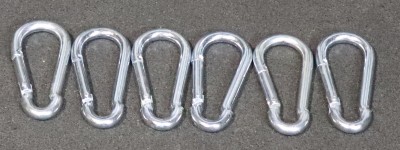
The G10 comes with 6 carabiners (aka spring snap clips) to connect the cable accessories to the pulleys or to connect multiple chains if necessary.
After all, attachments don’t do any good if you can’t attach them.
Extension Chains (4)
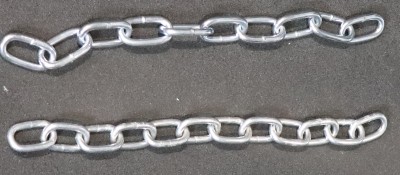
The G10 includes 4 extension chains. These chains help when you’re performing movements that require additional distance between you and the pulley.
Smith Machine
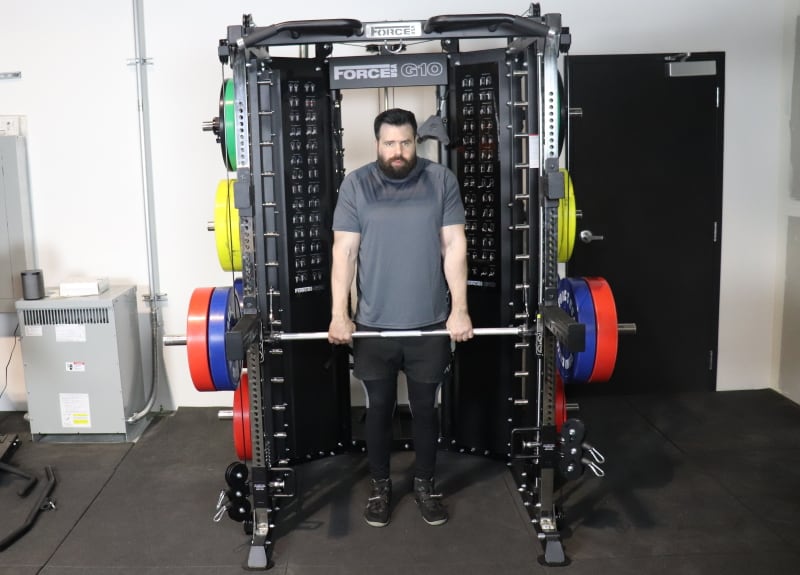
Buy the Force USA G10 – Use KING5 for 5% OFF »
The Smith machine features a barbell on a fixed track that glides vertically up and down. You can use the Smith machine to do a machine-assisted version of free weight barbell movements.
Fourteen steel pegs run adjacent to the track and enable you to rack the bar at different heights.
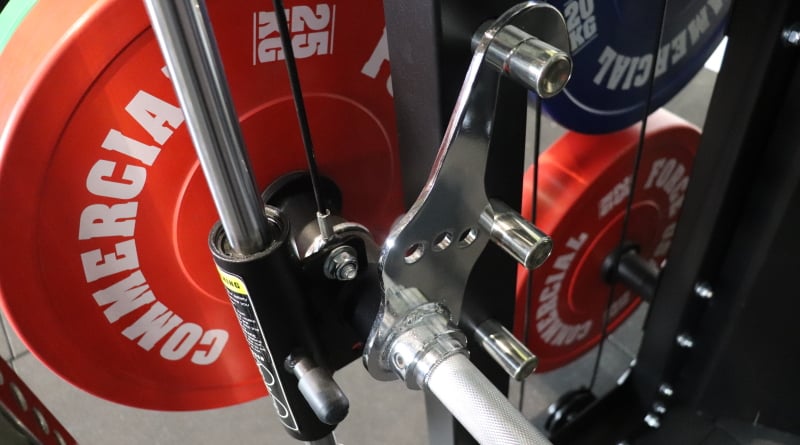
These pegs are an integral component of the safety spotting system. To use it, simply hook the safety catch to the peg at the desired height. This prevents the Smith bar from going any lower than this point. This safety feature should be used on any exercise where you could get stuck under the bar.
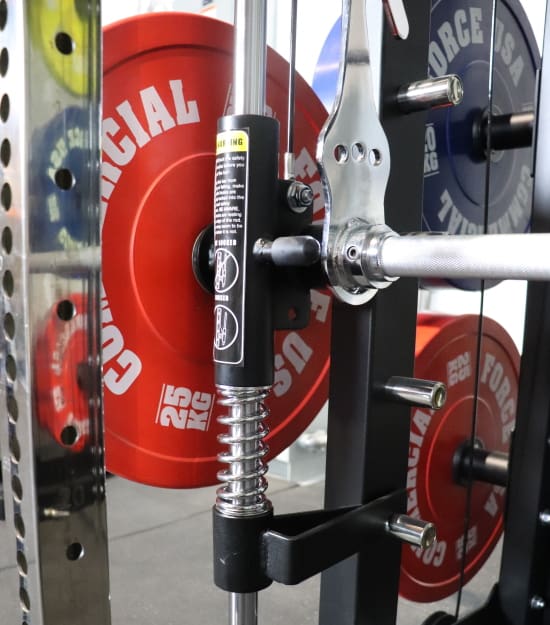
Despite the crap you’ve heard, a Smith machine is NOT a useless sissy machine. It does require a brain to use it correctly and some smarts picking your exercises.
That said, the fixed track isn’t a positive factor for certain exercises or training goals. It does force you into a fixed vertical plane of motion and eliminates your stabilizer muscles.
But in many cases, the fixed track is actually a big positive. It allows you to hone in like a laser when targeting specific muscles, so you get better activation and an improved mind-muscle connection. Don’t overlook this tool for building muscle.
The Smith machine is very popular with female lifters when it comes to the type of leg and glute training that many women love to do. The Smith machine is especially effective for these movements. You get a solid pump on these lower body muscles by being forced into a fixed plane of motion.
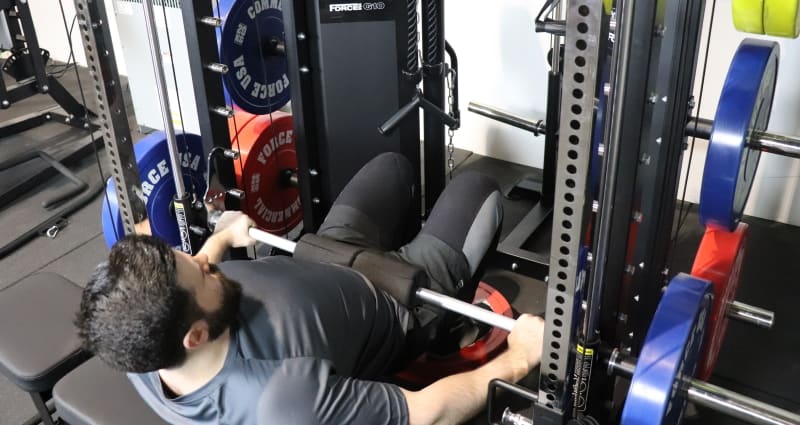
Here’s a taste of the many exercises you can do using the Smith machine:
- Smith machine flat bench press
- Smith machine incline press
- Smith machine seated press
- Smith machine decline push up
- Smith machine Bulgarian split squat
- Smith machine hack squat
- Smith machine RDL (stand on a weight plate or block to increase ROM)
- Smith machine seated calf raise
- Smith machine standing calf raise
- Smith machine single arm row
- Smith machine rear delt row
- Smith machine power shrug
- Smith machine drag curl
The Force USA G10 Smith machine is counterbalanced. A counterweight balances the weight of the Smith bar. Counterbalancing allows the bar to weigh in at zero pounds when empty. Otherwise, the bar would weigh around 45 pounds.
A counterbalanced machine is important to have if the user doesn’t have the strength to lift at least 45 lbs on some exercises. Without it, they’d be stopped before they even started.
While you may personally handle 45 lbs without a problem on any Smith machine exercise, if you are going to share your all-in-one trainer with a spouse or kids, they will love you for this.
If you are a personal trainer that works with novices or people recovering from injuries, this is also an important feature to have.
Hats off to Force USA for including the counterbalanced Smith machine on the G10 because it makes the all-in-one trainer more usable for more people. They included a counterbalanced Smith machine with the G9, G12 and G15 too. But the G3, G6 and G20 Smith machines are not counterbalanced.
Importantly, the G10 DOES allow you to do Smith machine incline press variations. There’s enough internal depth to put your adjustable bench far enough back so that you can position yourself under the Smith bar.
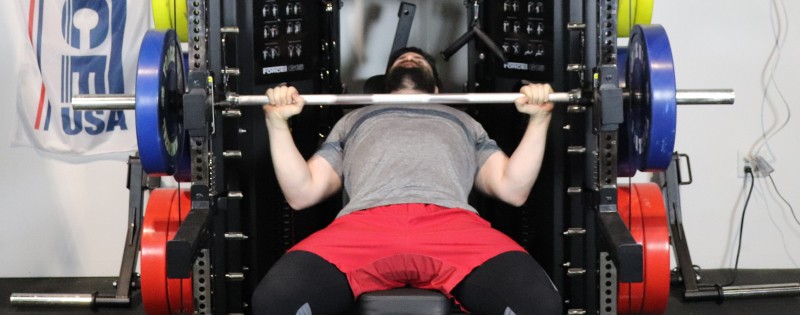
If you are like me, the incline Smith press is a favorite Smith machine exercise. It’s great for getting an intense pump/activation in the upper chest; something that’s hard to duplicate with free weights.
One of my biggest beefs with the G12 and G9 Smith machines is that their shallow internal depth makes incline Smith machine exercises impossible.
I need to point out that you may run into a couple of kinks when setting up for different incline angles on the Smith machine. Luckily, there are some easy hacks to get around these issues:
- Your bench’s backrest may run into a shelf, thereby blocking you from positioning the bench far enough back. To avoid this, you could install the shelf at height where it’s out of the way. Alternatively, you can switch the direction of your bench so you’re facing inside the unit. The only negative of this solution is that your legs may bump up against the shelves and walls of the unit. It feels cramped, but still works; luckily, this only happens when using low incline angles.
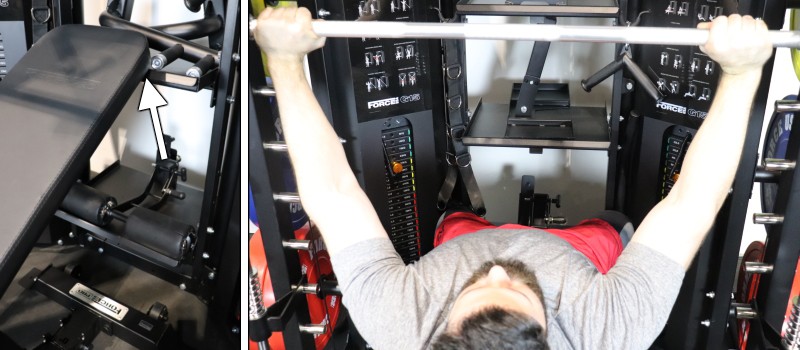
- If you’re setting up to use a fully upright or high incline bench angle, you must turn your bench to face inside the machine. This way, you’re able to position the bench even further back so you can get under the Smith bar for a proper setup. In this scenario, you avoid the issue of your legs bumping into the unit because the bench is further back when you’re using high incline settings.
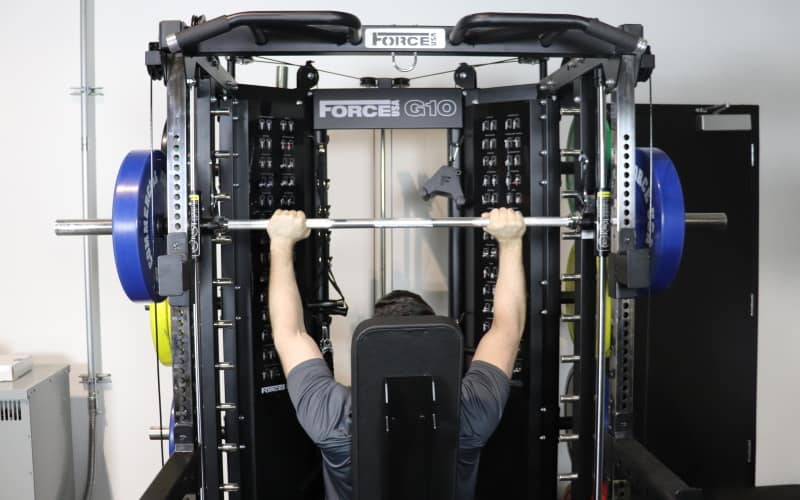
Like the other Force USA units, the G10 Smith machine sleeves are 12” long. It would be better if they matched the length of a typical barbell; more like 16”.
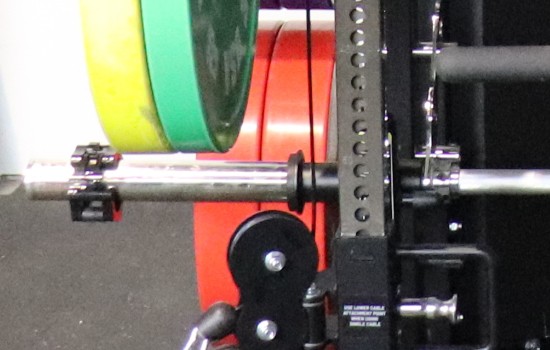
You still have enough room to add the weight you want, especially if you use thin cast iron plates. If you use the thicker bumper plates, you may fill the sleeve; even then, you should have sufficient weight for your Smith machine exercise needs. But if you want additional resistance, you can get it by attaching resistance bands to the band pegs.
The Smith machine’s max weight capacity is 794 lbs, which is plenty for Smith machine training.
The G10 and the G15 are the only units that use a compression spring as a stopper at the bottom of the Smith guide rods. This is a big step up from the rubber stopper used by the other units. A compression spring offers more durability as it absorbs greater impact force than a rubber stop. That’s important if you drop the weight or accidentally bottom out fast.
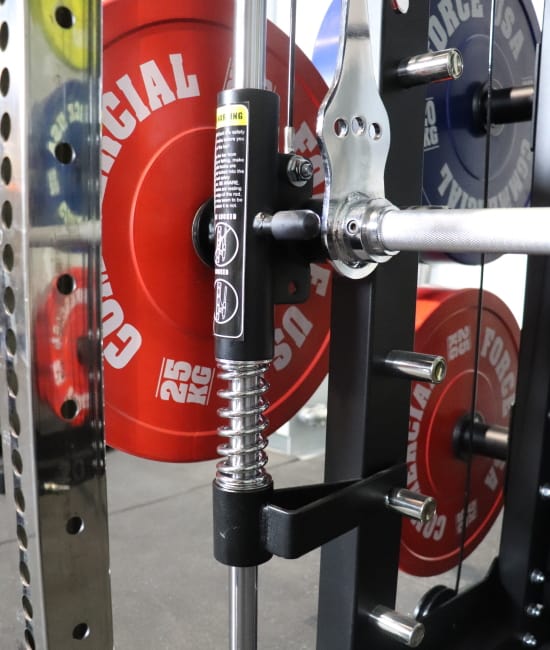
You give up some range of motion because the compression spring is a few inches taller than the rubber stopper.
Resting on the compression spring stoppers, the Smith bar is 18” off the floor at its lowest position. I’m 5’11” so this puts the bar at knee height for me. Because the other G-Series units don’t have spring stoppers, this is a couple of inches higher than they measure.
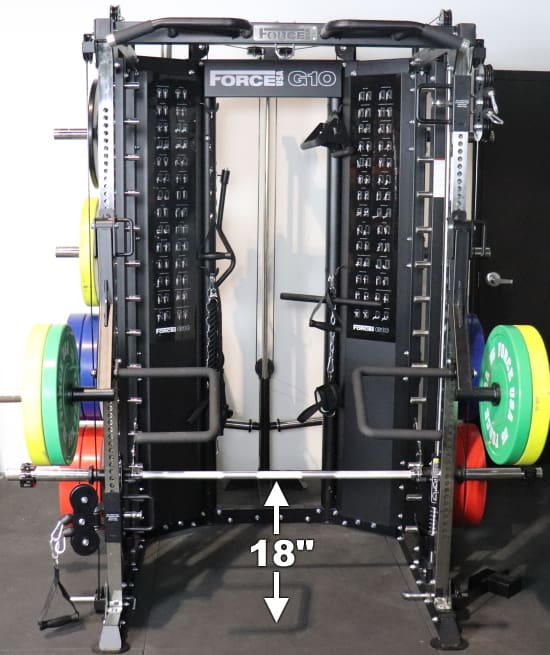
This may be too high to allow you to get the range of motion you want for some exercises. That includes Smith machine RDLs and Smith machine hip thrusts.
But you can get that range of motion back by simply standing on a weight plate (or multiple plates stacked), an aerobic step platform or a sturdy box. See the clip below for an example of this:
The Force USA G10 Smith machine bar’s highest rackable height is 69” (5’9”). This measurement is important as it determines if you can set the Smith bar up and out of the way to easily walk under it without ducking. For the G10, this works if you are under 5’9”.
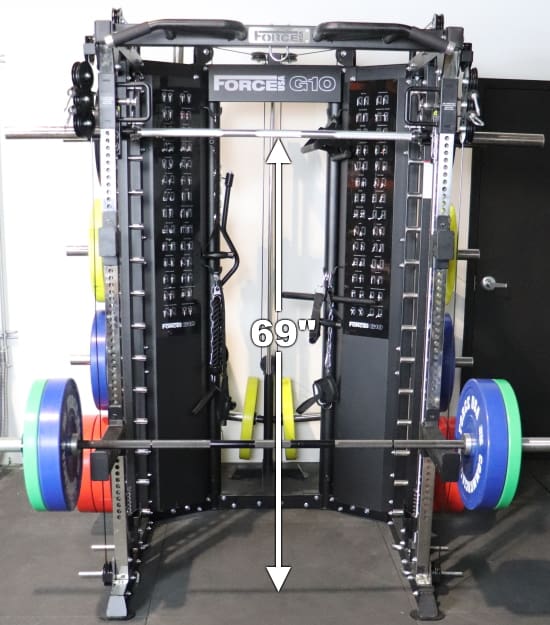
The highest rackable Smith bar height for the other units is:
- G3: 68″ (5’8″)
- G6: 77″ (6’5″)
- G9: 65″ (5’5″)
- G12: 65″ (5’5″)
- G15: 69” (5”9”)
- G20: 73.5″ (6’1.5″)
The highest absolute Smith bar height is 74” (6’2”). After this, it hits the top of the machine during exercise. This measurement is important because it determines if you can do a standing overhead press on the Smith machine. This exercise won’t be possible for most people.
To get the full range of motion for a standing overhead press, you would probably have to be under 5’5”.
Like the G20 and the G15, the G10 Smith machine lacks removable sleeves for using standard-sized weight plates (1” hole diameter). In comparison, the G3, G6, G9 and G12 include this feature. I don’t see this as a negative for the G10 since almost everyone who gets the G10 will use Olympic plates anyway.
Unlike a regular barbell sleeve, the G10 Smith machine sleeves aren’t constructed of solid steel. The outer layer is a metal casting and there is plastic beneath this. Under the plastic is steel. It’s similar to the Smith machine sleeves on the other G-Series units.
If it were a regular solid steel barbell sleeve, it would be stronger. Still, it’s solid enough for normal use since you can’t drop a Smith bar on the floor.
Chin Up Station
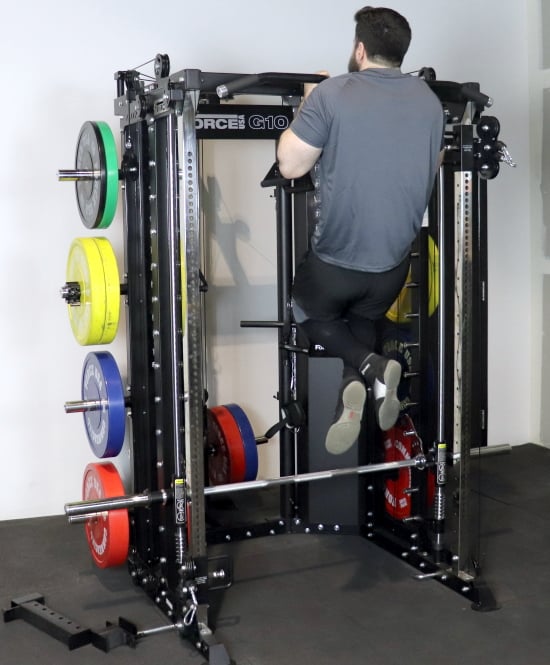
Buy the Force USA G10 – Use KING5 for 5% OFF »
The Force USA G10 All-In-One Trainer features a multi-grip chin up station incorporated into the front, upper crossmember.
It’s identical to the G15 chin up station.
And it’s very similar to the chin up stations on the G6, G9, G12 and G20. The G10 (and G15) chin up station differs in that it offers light knurling on the powder-coated steel portions so you get a better grip.
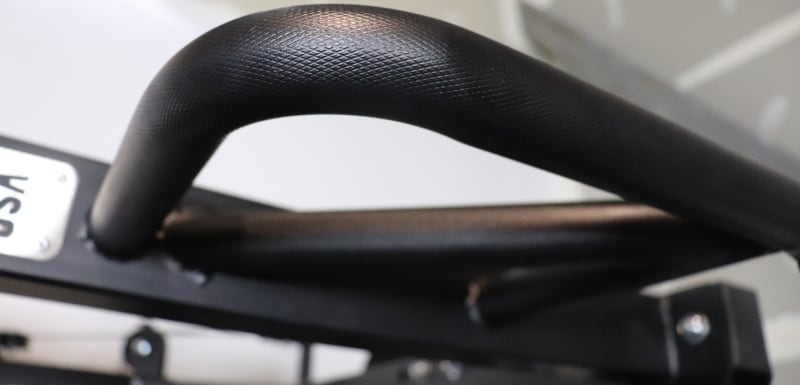
I’ve criticized Force USA for the lack of chin up bar knurling in my reviews of their other units. So this is a definite improvement. Even if the knurling is passive, the grip improvement is noticeable.
The multi-grip station offers these bars:
- 4 short parallel bars for a close neutral grip or a medium/wide neutral grip.
- 2 short diagonal bars for a medium semi-supinated grip (or a semi-pronated grip if you’re inside the rack, facing the other way).
- 2 long bars in the front, perpendicular to the 4 short parallel bars. There is a straight portion and the end is angled down. You get a narrow or medium-width pronated or supinated grip with the straight portions. And you get a wide pronated grip with a more ergonomic wrist position when you use the angled portions.
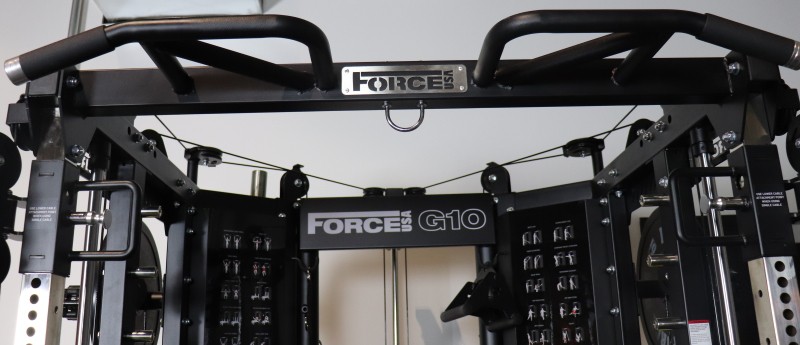
The different combinations of bar segments offer a ton of exercise possibilities. Just consider these chin up variations:
- Close neutral grip chin ups
- Medium neutral grip chin ups
- Close supinated grip chin ups
- Medium supinated grip chin ups
- Close semi-supinated grip chin ups
- Medium semi-supinated grip chin ups
- Close pronated grip chin ups
- Medium pronated grip chin ups
- Wide pronated grip chin ups
- Medium semi-pronated grip chin ups
I demonstrate a few of these variations in this video. Check it out:
The angled-down section of the multi-grip bar features a rubberized cover which gives you a better grip. That comes in handy (pun intended) when you’re doing wide-grip chin ups.
The rubberized sections have a 38mm (1.5″) diameter. The powder-coated sections have a 33mm (1.3″) diameter. Both diameters feel good and hit the sweet spot of not too thick or too thin.
The only G-Series model with a significantly different chin up station design is the G3. It looks quite different, but it has almost all of the same bar angles.
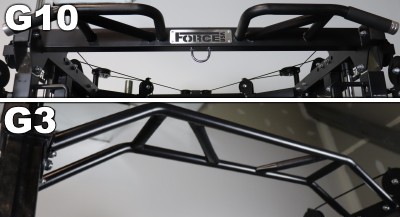
The biggest difference is the absence of a close neutral grip on the G3 bar. Also, the G3 doesn’t provide rubberized grips on the angled portions.
Ceiling Clearance Necessary for Chin Ups
Vertical clearance can be a problem with some G-Series models if you’re planning on putting your unit in a room with lower ceilings. Fortunately, the G10 isn’t a very tall all-in-one, so you’ll probably have plenty of clearance for pull ups without bashing your head into the ceiling
About 10-12” of clearance above the chin up bar is required to perform a full range of chin ups. At 82” high, the chin up bar requires a minimum ceiling height of 7’8” (92”) in order to use it. This is just 5” more than the total unit height.
Lat Pulldown Station
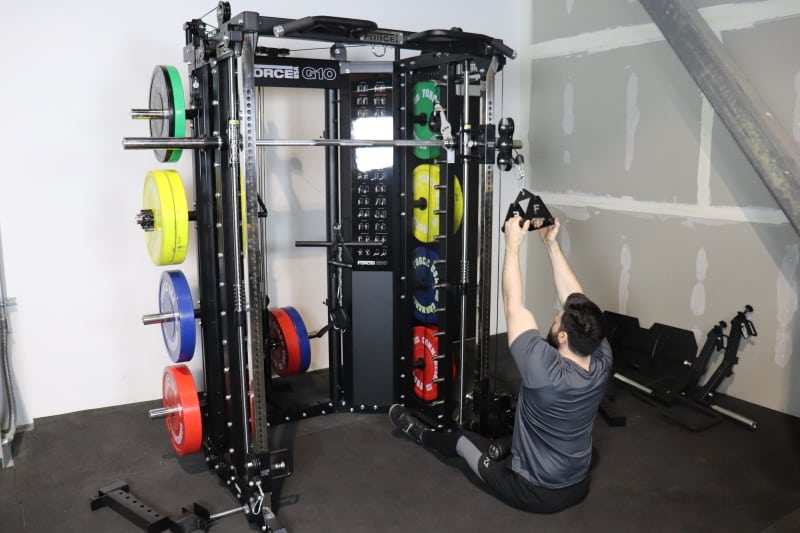
Install the lat pulldown leg holder attachment to either of the functional trainer columns to create the lat pulldown station.
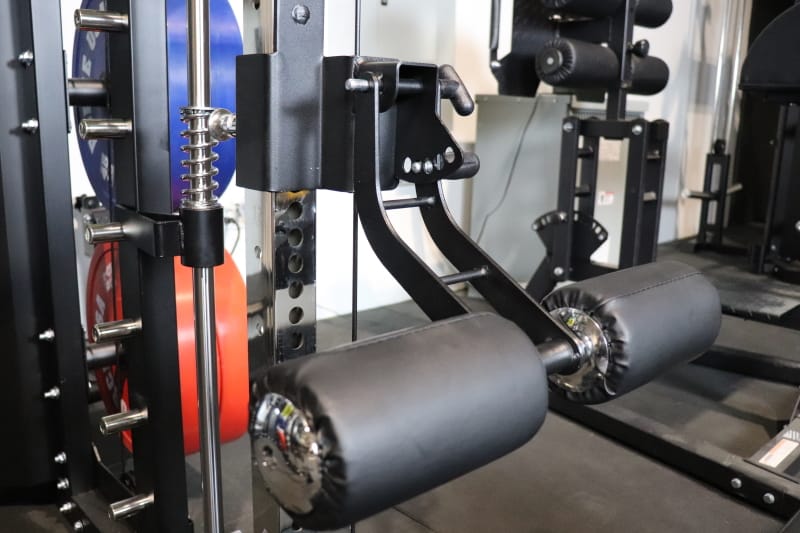
To use the station, sit on the floor (or on a bench if you can get a full stretch). Simply adjust the height of the leg holder attachment on the upright, and you are set.
I just sit on the floor because the Force USA G10 isn’t a tall unit. Because I’m 5’11” and have quite a long reach, I can’t get the full range of motion on lat pulldowns if I sit on a bench.
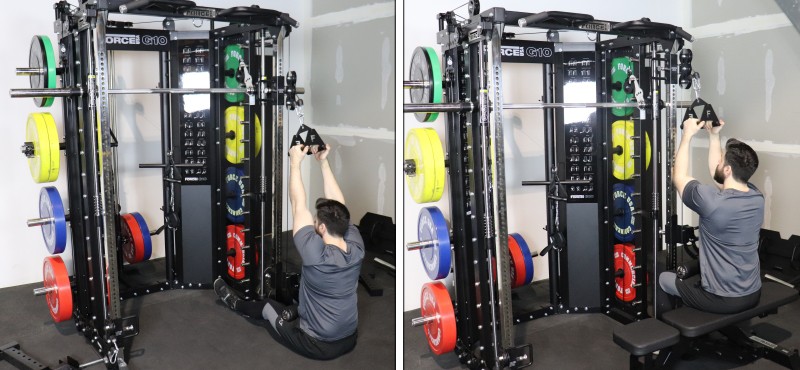
I was pleasantly surprised by how well the floor-seated lat pulldown works. Simply sit and stretch your legs on either side of the functional trainer column. It’s a very stable position and you can get directly under the pulley for a vertical line of pull. Use the leg holder and you’re securely locked down.
Only short people can get a full stretch using a bench to sit on. I estimate you’d have to be around 5’5”-5’7” and shorter to get a full range of motion on pulldowns while seated on a bench.
The highest pulley setting is 72.5” (6’0.5”) measured from the floor to the spot where the lower cable comes out of the trolley. As you can see, when compared to the other G-Series units, it’s the same as the G15 and shorter than the other units.
- G3: 76″ (6’4″)
- G6: 81″ (6’9″)
- G9: 73″ (6’1″)
- G12: 73″ (6’1″)
- G15: 72.5” (6”.5”)
- G20: 81″ (6’9″)
Now if you are tall, the G6 and G20 offer you room for full extension on pulldowns while sitting on a bench. You can still use the G3 if you are on the average/tall side. It will give you a few extra inches over the G10 and G15, and it includes a seat attachment that you can position closer to the floor.
For the G10, G15, G9 and G12, most people should perform pulldowns seated on the floor.
You’ll be able to use as much weight as you need for lat pulldowns on the G10. If you’re using regular cast iron Olympic plates, you can get up to 360 lbs of resistance with the 2:1 ratio. That’s way more than you’d ever need for pulldowns.
This is one benefit of the G10 over the G15. The G15’s selectorized weight stacks allow for just 142.5 lbs for lat pulldowns. While that’s plenty for most lifters, some stronger individuals may want more. And as I recommend in my Force USA G15 review, you can buy a 10mm weight stack adapter pin like the Gym Pin or BSE Stacked Weight Pin to add Olympic plates onto the back of the weight stacks…
…But the point is you don’t need any workarounds to get a lot of weight on the G10’s cable system. You just need enough weight plates.
The cable moves smoothly on lat pulldowns, just like all functional trainer exercises.
In addition to using the rack’s 1” hole spacing to get the right height for the leg holder attachment, you can get even more precise positioning. The attachment itself gives you 5 micro-adjustment settings for the perfect fit against your thighs. Just insert the pin in the hole that offers the most comfortable fit.
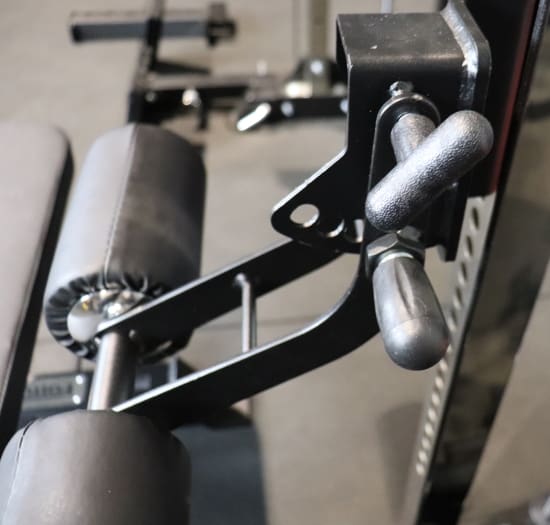
The attachment feels secure when in use – even if there is a bit of play if you move it when it’s not against your thigh.
This is the same leg holder attachment that comes with every unit except for the G3. The G3 comes with a pretty cool seat attachment.
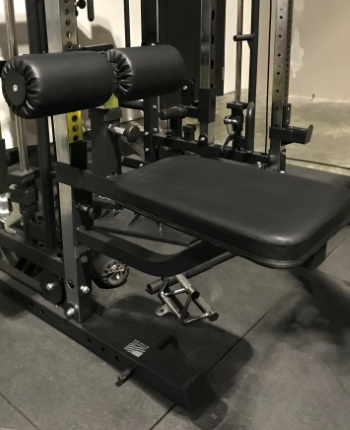
Of course, the G3 seat attachment has some sway when you lean back. And if the G10 had a seat attachment, you couldn’t do pulldowns sitting on the floor.
Low Row Station
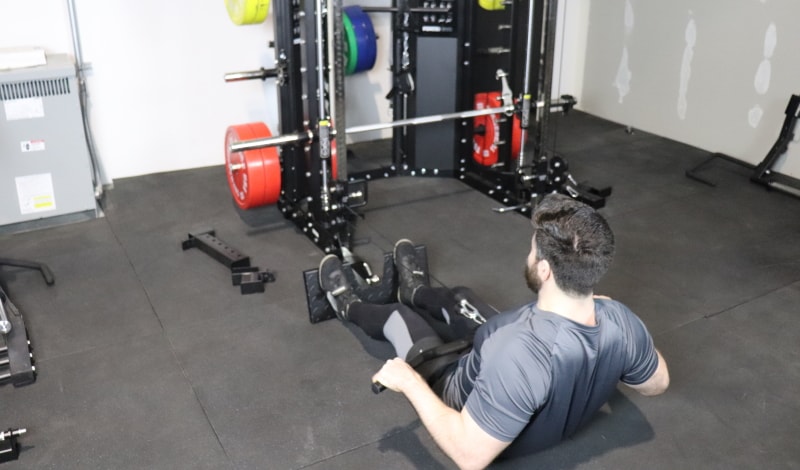
Buy the Force USA G10 – Use KING5 for 5% OFF »
The Force USA G10 All-In-One comes with a footplate attachment designed for performing low rows on the functional trainer.
Because I’m a big fan of low rows, I’m stoked about the specialized attachment Force USA added to the G10. The G15 functional trainer, of course, has the same attachment.
The G20, G12, G9 and G6 functional trainers lack this feature. For these models, you must utilize the lat pulldown leg roller pad as your makeshift footplate to do low rows on the functional trainer. The G3 lacks this makeshift option so you’ll have to figure something else out.
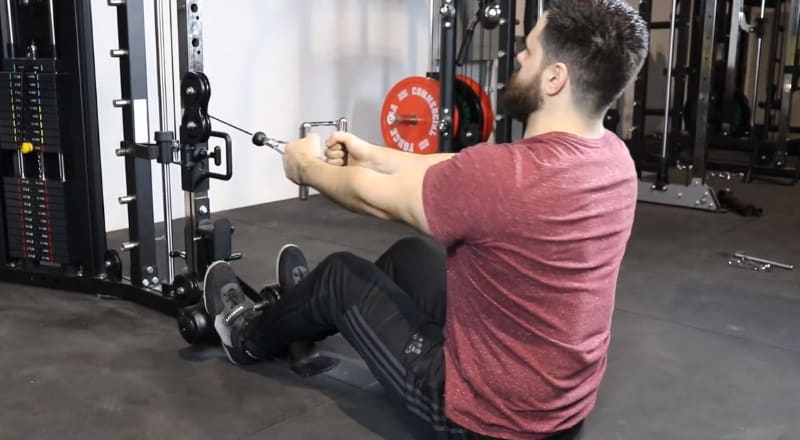
Of course, the G9 does have a dedicated low footplate that’s built into the frame. It’s not on the functional trainer but is located inside the rack. And the G20 offers a dedicated built-in low row footplate but it isn’t standard. It’s only available when you buy the optional G20 Lat Row Station Upgrade.
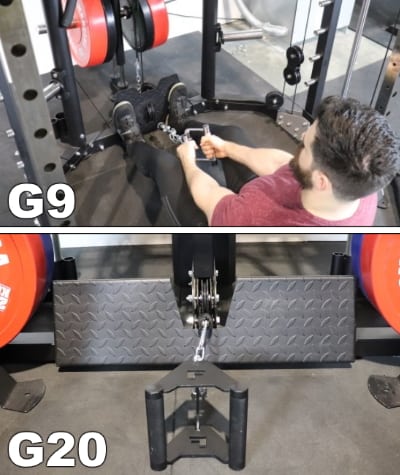
The Force USA G10 footplate attachment is well-built and stable. The solid steel construction features a diamond steel pattern that prevents your feet from slipping.
The footplate is 9” x 22” and offers enough space to comfortably position your feet.
A center cut-out provides the perfect place to rest your cable attachment between sets.
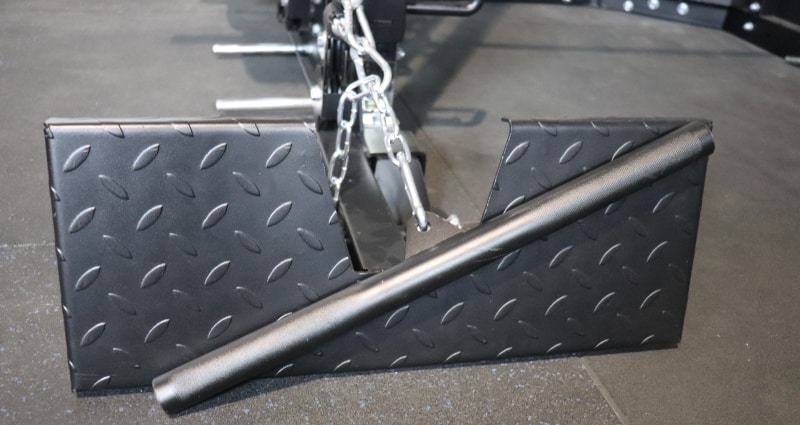
Installing the footplate attachment is fast and easy. Attach the footplate to the front of the left rack foot by simply inserting one of the included band pegs through it. To remove the footplate, remove the band peg.
You can modify the angle of the plate using one of the 3 pop-pin settings. Keep it upright or angle it slightly back to conform to what’s most comfortable for your feet and ankles.
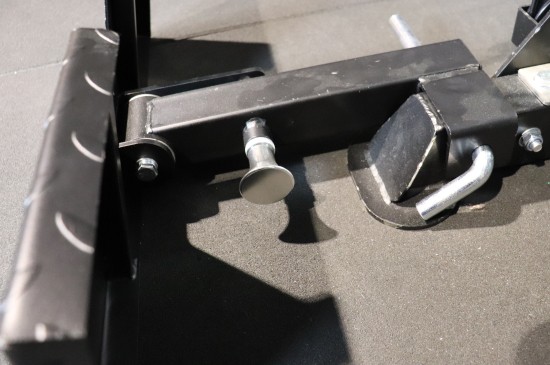
Dip Station
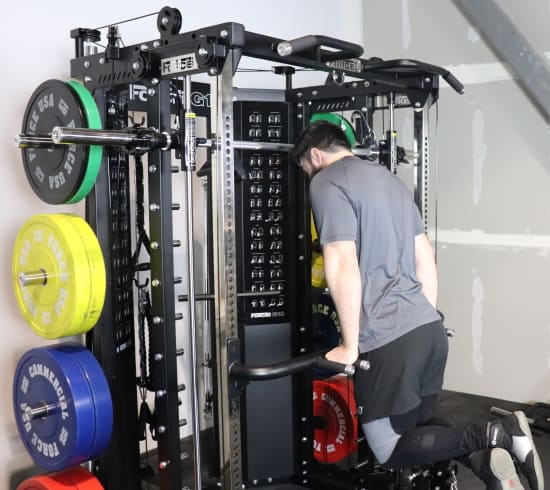
The dip station offers you 2 separate dip handles to attach to each of the power rack uprights at whichever height you want.
The handles offer 2 grip widths:
- A narrow/medium grip places the handles 20.5” apart. It is most suitable for smaller-framed lifters or for doing triceps-focused dips.
- A wider grip places the handles 26.5” apart. It is most suitable for wider-framed lifters or for doing chest-focused dips.
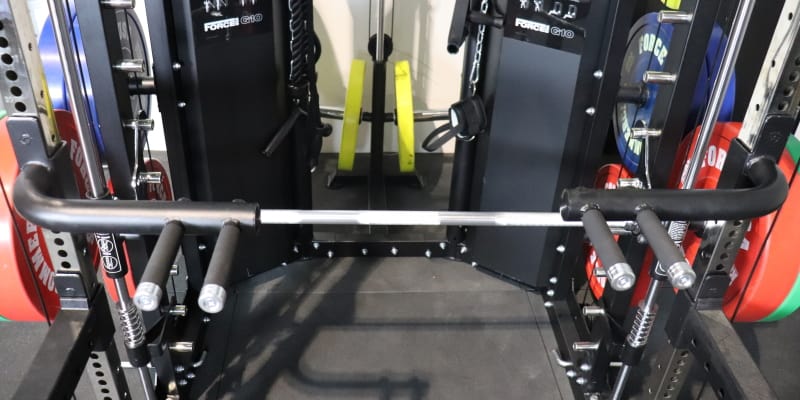
The G6, G9, G12 and G15 use the same style of dip bars. The G20 offers a Matador-style (Y-shaped) dip station as part of the Lat Row Station Upgrade. The G3 doesn’t have a dip bar.
The handles are steel with rubberized grips. The grip diameter is 30mm and feels very comfortable during dips.
Two individual handles installed between the uprights give you a few advantages over the Y-dip bar style that you see on many other power racks:
- It positions the body in the middle of the unit, instead of to one side, so it’s a more stable setup.
- It allows you to position your body facing the unit or away from the unit.
- It gives you the freedom to lean as far forward as you want without bumping your head into an upright.
The obvious exercises for this dip station include:
- Narrow grip dips
- Wide grip dips
But, you can also use this dip station for:
- Band-assisted dips
- Scapula dips
- Incline push-ups
- Inverted rows
- Inverted shrugs
Suspension Trainer Ring
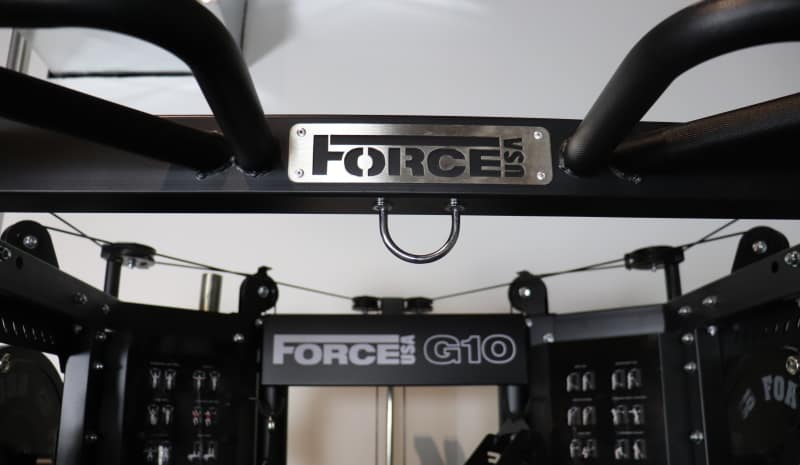
Buy the Force USA G10 – Use KING5 for 5% OFF »
The suspension trainer ring offers the perfect location and mechanism for hanging certain accessories to expand your training options.
The first and most obvious attachment is a suspension trainer unit like the TRX. The G10 doesn’t include a suspension trainer. You’ll have to buy one separately if you want this capability.
A suspension trainer is just the start. Here are other attachments you can hang:
- Attach a resistance band to perform band-resisted and band-assisted exercises.
- Hang a heavy bag for your cardio workout.
- Store a cable exercise attachment when not in use.
The suspension training ring is created by a U-bolt that’s installed from the bottom to the top of the upper cross member.
This setup safely supports a lot of weight because you get the combined strength of the robust hardware and the frame of the entire unit.
Use this station for a variety of suspension trainer exercises:
- Suspension trainer row
- Suspension trainer push up
- Suspension trainer chest fly
- Suspension trainer reverse fly
- Suspension trainer dip
- Suspension trainer biceps curl
- Suspension trainer glute bridge
- Suspension trainer pistol squat
- Suspension trainer jack-knife
- Suspension trainer rollout
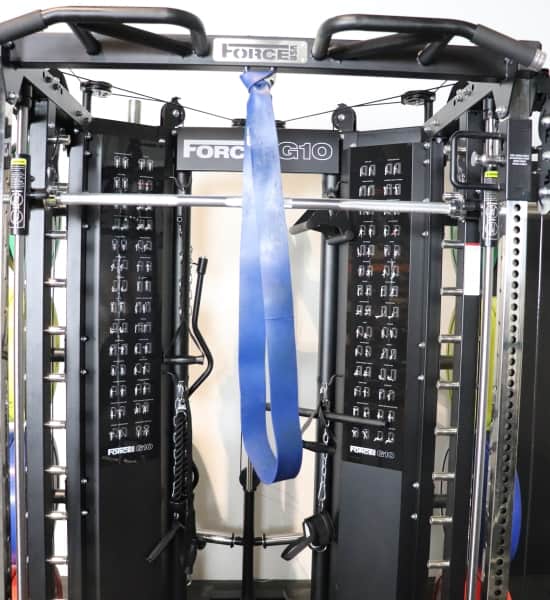
If you loop a resistance band through the ring you can do these exercises:
- Band-assisted dip
- Band-assisted pull up
- Band-resisted face pull
- Band-resisted lat pulldown
- Band-resisted straight arm pulldown
- Band-resisted triceps extension
Included Accessory Storage
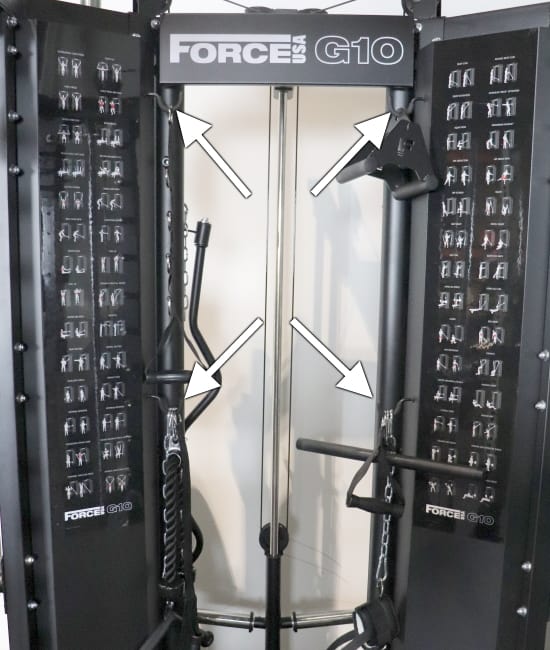
The Force USA G10 All-In-One Trainer offers some pretty handy accessory storage. This includes:
- 4 hooks on the inside
- 4 hangers on the rear
The hooks are easily accessible because they’re inside the machine so this is where you should store your most commonly used accessories.
However, if you buy the optional storage shelves you will run into a slight problem depending on where you install the shelves. If you put the shelves too close to the storage hooks it’s harder to put things on the hooks. Simply avoid this problem by putting a little thought into where you install the shelves and don’t line the shelves up with the storage hooks.
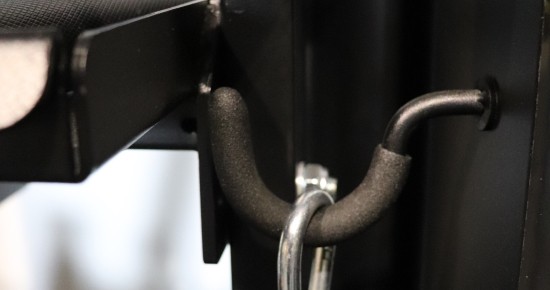
The two-pronged hangers on the back work for accessory storage just like a hook. These are great for storing accessories like the EZ curl cable bar because it easily hangs between the two prongs.
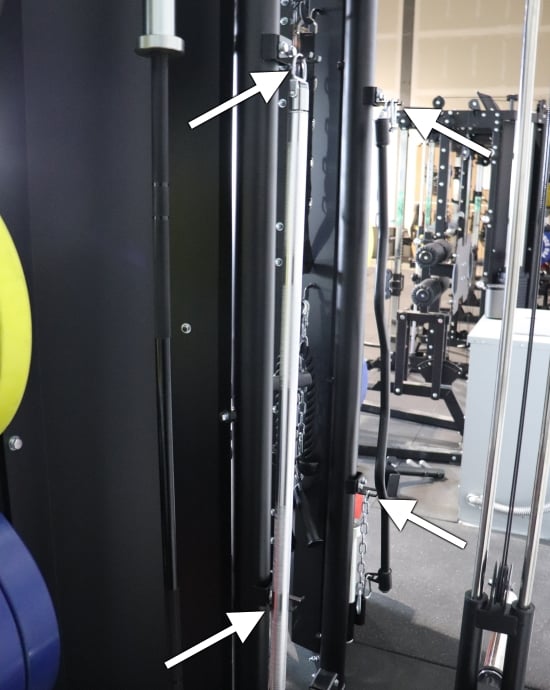
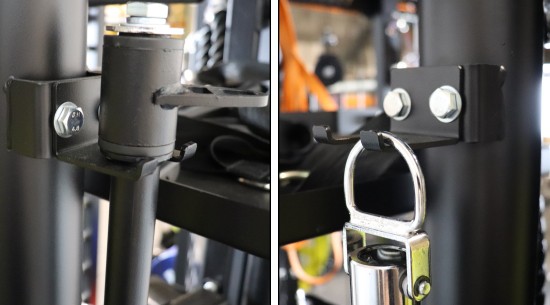
Right: Hooking an attachment onto one of the two prongs on a hanger.
These 8 accessory storage points on the G10 provide plenty of storage for the included cable accessories. Remember, you can always put more than one item on a hook or hanger.
If you want extra storage, then go for the upgrade kit that provides the storage shelves. These are perfect for storing larger power rack and functional trainer attachments.
You can also consider Wall Control, a modular metal pegboard system that installs on the wall. It’s a popular approach for storage in a compact home gym. If you go this route, use my Wall Control coupon code KING and get 10% off.
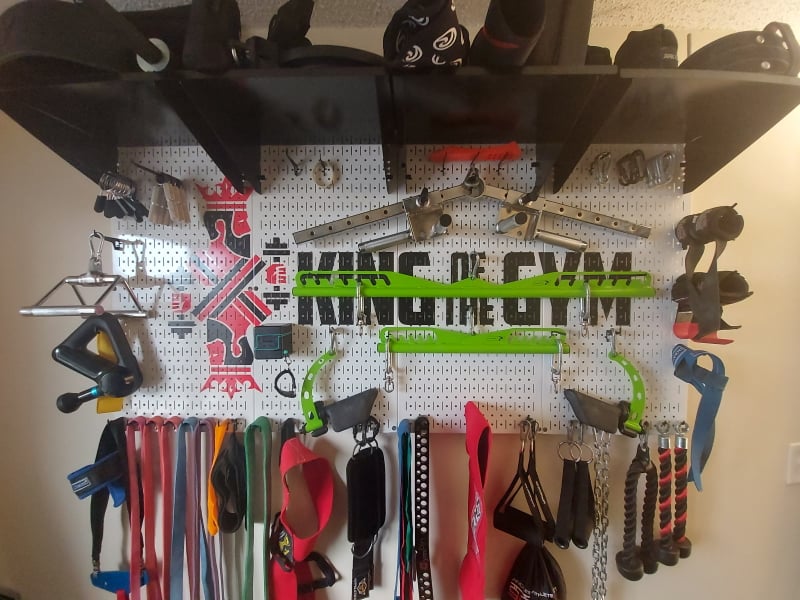
Barbell Storage
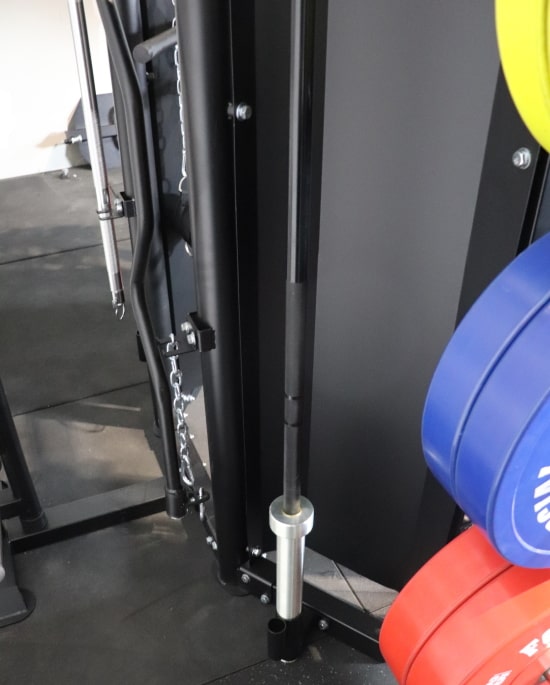
The Force USA G10 All-In-One Trainer provides 2 barbell holder brackets located directly behind the trainer.
Each bracket provides an Olympic barbell holder and a standard barbell holder.
This setup allows you to store 2 Olympic barbells (~2” sleeves) and 2 standard barbells (~1” sleeves).
In reality, most people don’t have standard barbells so those won’t be used to hold barbells. But they are great for storing small, thin accessories like the band pegs, so they won’t go to waste.
If your gym has just one or two barbells, the Force USA G10 will meet your barbell storage needs.
The top of the barbell holder is 7” from the floor. So, add that to the length of your bar to make sure you have enough vertical clearance.
Assuming your Olympic bar is the standard 86.6” (220cm), you’ll need a minimum ceiling height of 93.6” (7’9.6”) to use the vertical barbell storage feature. This figures in the height of the bar while stored and the room needed to lift the bar into or out of the holder.
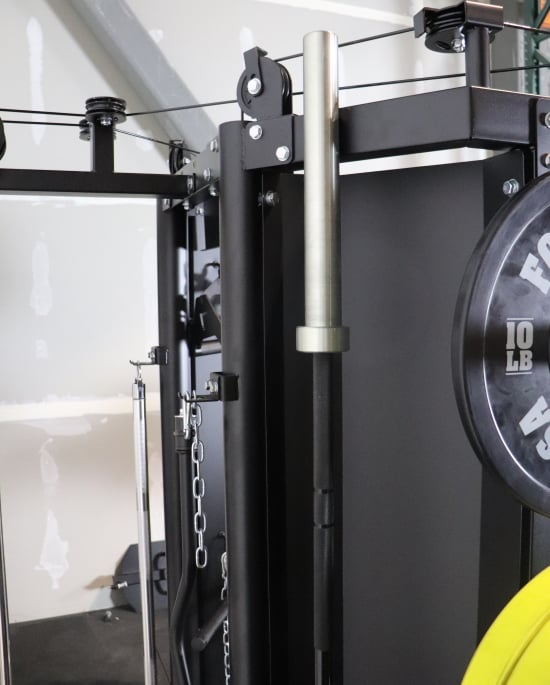
If your ceiling is lower or you need to store more than 2 barbells, a wall-mounted barbell storage system like this horizontal bar rack or this vertical bar hook will better suit your needs.
Weight Plate Storage
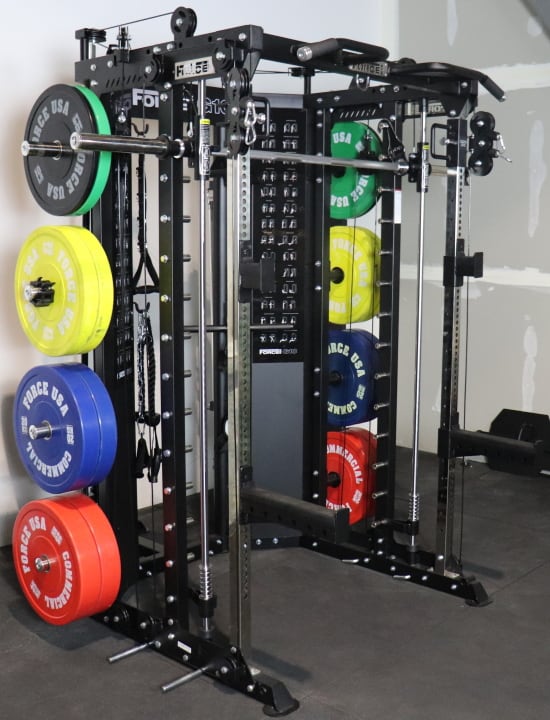
Buy the Force USA G10 – Use KING5 for 5% OFF »
The Force USA G10 (and G15) offers the best plate storage layout of all the G-Series models.
You get 4 storage pegs per side for a total of 8 pegs. The G12, G9, G6 and G3 only provide 3 pegs per side for a total of 6 pegs. 6 pegs should be enough for most people, but I’ll always prefer more pegs if I have the option.
Additional pegs give you room to organize plates by weight. And if you are one of those folks that just have a ton of plates, you need room to store them.
The G20 gives you 5 storage pegs per side for a total of 10 pegs. But in this case, more pegs doesn’t (necessarily) mean you can use them all at once. That’s because the G20 storage pegs get closer together as you move up. Now, it’s not a problem if you store your 45s at the bottom, the 35s next, the 25s next and so on to the top. But if you use bumper plates, which are all the same diameter or if you have many 45s you want on multiple levels, this peg configuration won’t work.
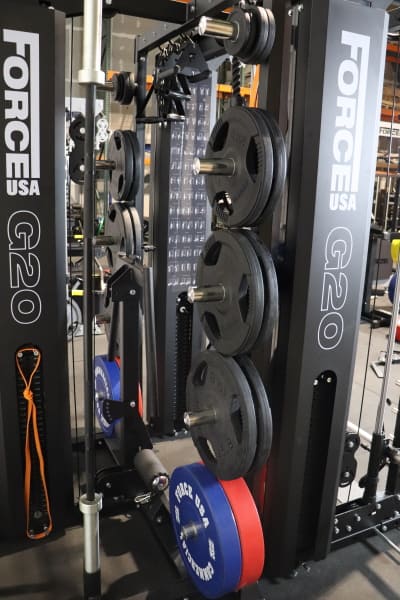
The G10 peg configuration solves this problem by offering one less peg, but spacing them evenly. As a result, you can place full-diameter plates on each level.
The storage pegs are 8” long. This length works, but a couple of extra inches would be nice. The other G-Series units also offer 8” pegs.
The number of plates you can store per peg depends on the thickness of the weight plates.
If you have regular cast iron plates that are 1.5” thick, you can store up to five 45 pound plates on a peg. But if you use the thicker bumper plates, you’ll only get three 45 pound plates or two 55 pound plates per peg.

I like the way the weight storage area is located on the sides, towards the rear of the G10. This location makes changing weight easy and efficient because you’re right there at the Smith machine, the power rack and the plate-loaded weight carriage. I think this works more efficiently than the placement of the plate storage on the G20 and G3, which is off the back.
The weight storage pegs on the G10 are made from the same materials as the G20 and they look the same too. They are very similar to the weight pegs on the G12 and G9. The only difference is how they are assembled.
The G10 storage peg is made by placing a metal casting over a steel rod and then capping the peg with plastic. This construction gets the job done and should hold up to normal use.
But I wish they had just created a steel peg with powder coating. It would have made the peg simpler and more durable. Just my two cents.
Exercise Chart
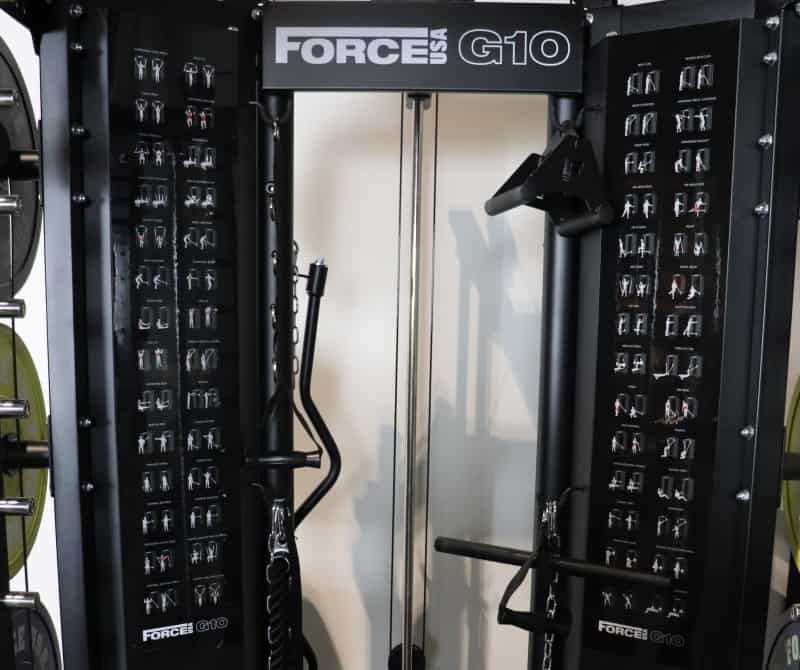
Inside the rack, you’ll find 2 functional trainer exercise charts.
The 2 charts give you a total of 52 exercise diagrams. Only the G15 provides as many exercise diagrams.
The G20 displays 42 exercises, the G12 and G6 display 37 exercises and the G9 displays 35 exercises. You’re on your own with the G3 – it provides no exercise charts.
Unless you are a newbie, you might not even use these charts. You may already be familiar with the most common cable exercises or already have a set regimen.
But that doesn’t mean these charts aren’t helpful or add value. This is especially true for people who are newer to lifting or just starting out with a functional trainer.
No matter your level, I think you’ll find the charts are great for some quick exercise ideas and inspiration.
Band Peg Holes + Band Pegs
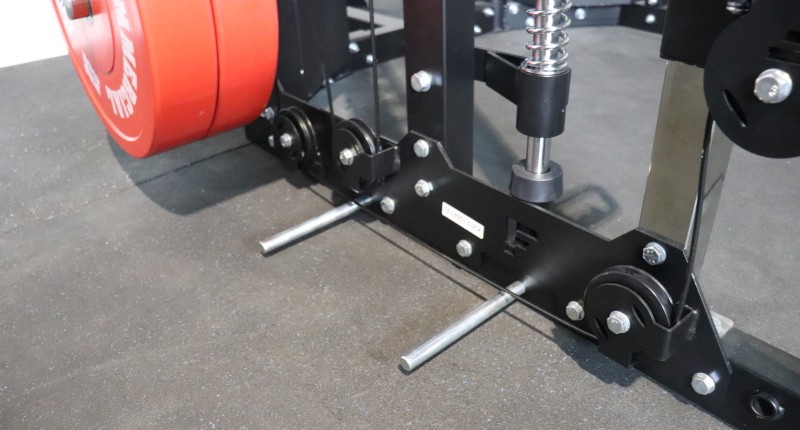
Band peg holes are where you put band pegs. And band pegs provide an anchor point to attach resistance bands to whatever you’re lifting, whether that’s a barbell or Smith machine.
Resistance bands make the exercise more challenging at the top of the movement and this helps train explosiveness.
The Force USA G10 offers 4 band pegs for use in any band peg hole.
Each foot of the machine has 2 band peg holes around the Smith machine region. These band peg holes let you add band resistance to your Smith machine exercises.
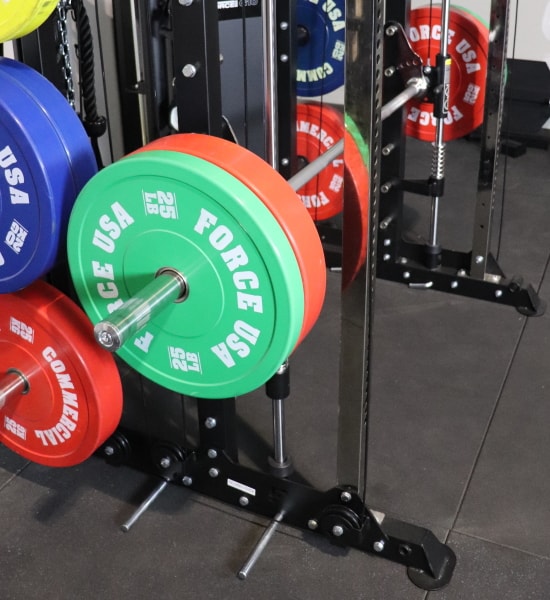
They also allow you to add band resistance to the optional jammer arms.
The G10 doesn’t have band peg holes around the power rack area like the G3, G6 and G20. This precludes adding band resistance to free weight exercises.
But it makes sense when you think about it. The G10 is so compact. The front feet don’t extend far enough forward to make band peg holes work in the power rack area.
The Force USA G10 provides 3 upper band peg holes in the Smith machine area. Use these to attach resistance bands from the top of the unit to Smith machine sleeves. This lets you flip things around and make the load lighter at the bottom of the range of motion when doing exercises on the Smith machine.
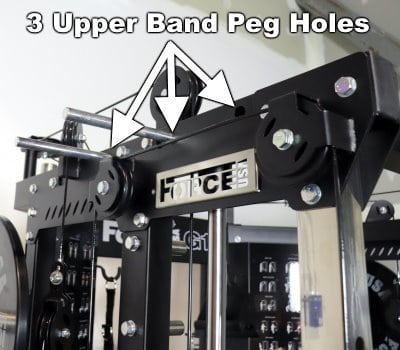
The Force USA G10 and G15 are the only models that offer both upper AND lower band peg holes. The G3, G6 and G20 only have lower band peg holes, and the G9 and G12 totally lack band peg holes.
Jammer Arms (Optional)
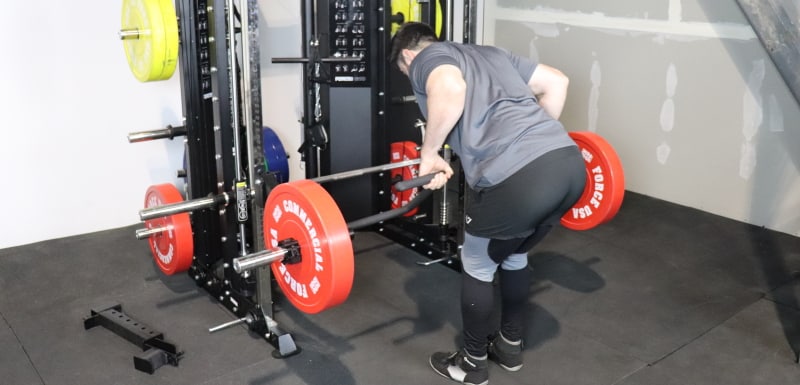
Buy the Force USA G10 – Use KING5 for 5% OFF »
Before the development of the Force USA G10 and G15, jammer arms were the most requested feature for the G-Series units. Force USA listened to what customers had to say and offers them as part of the G10/G15 optional upgrade.
Jammer arms attach to the power rack uprights, are plate-loaded and swing out on a hinge.
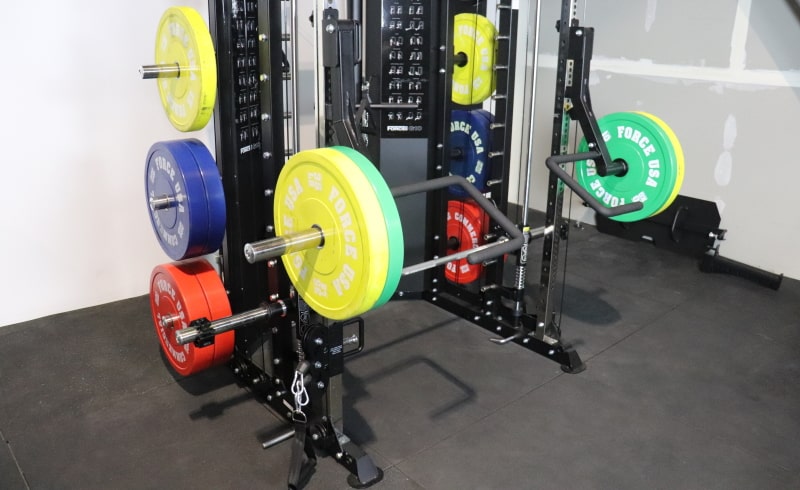
They are great to emulate the training you get with Hammer Strength-style plate-loaded machines you see in commercial gyms.
Jammer arms are versatile because:
- Their height is completely adjustable.
- They offer different starting positions depending on whether you rest them against the uprights or on the spotter arms.
The jammer arms are bent ~30 degrees near the middle of the arm instead of being straight like other jammer arms on the market.
The angle makes it easier to prop the jammer arms up on the spotter arm. This way, the jammer arms start at a more horizontal position.
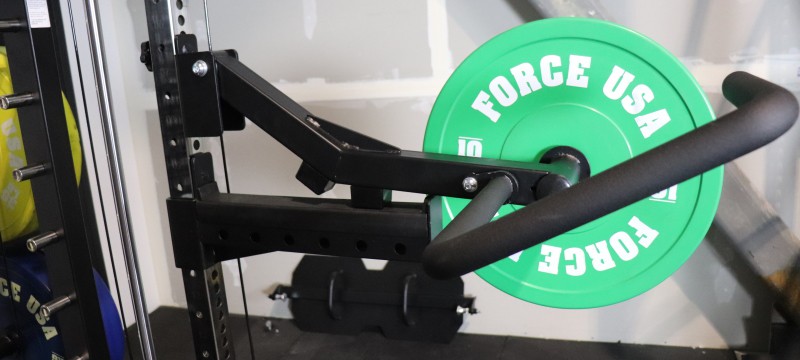
This positioning allows you to perform movements that require you to be under the load instead of behind it or in front of it. Think of the positioning for the flat bench press, incline bench press and standing shoulder press.
The bend in the arm has a rubber bumper on either side of it. This prevents metal-on-metal contact when the jammer arm is against the power rack upright or the spotter arm.
The jammer arm handles give you 1 pair of neutral grip segments and 2 pairs of straight grip segments.
The two pairs of straight grip segments are important because they provide different leverages. Use the pair closer to the power rack to make the load feel heavier and use the pair further away to make it feel lighter.
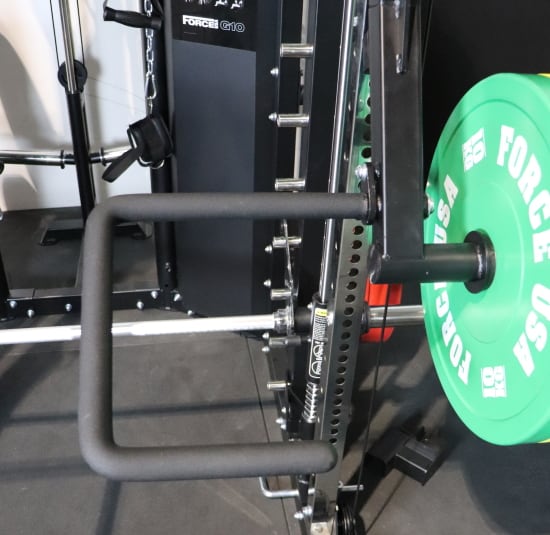
A rubberized covering on the handles improves the grip and gives you a good tacky but comfortable feel in the hand.
The jammer arm weight plate holders are the same sleeves used on the Smith machine and each one is 12” long. That’s enough room for you to load the weight you need for virtually any jammer arm exercise.
You can even add cable resistance to the jammer arms by connecting the pulleys to the jammer arm weight holders with chains.
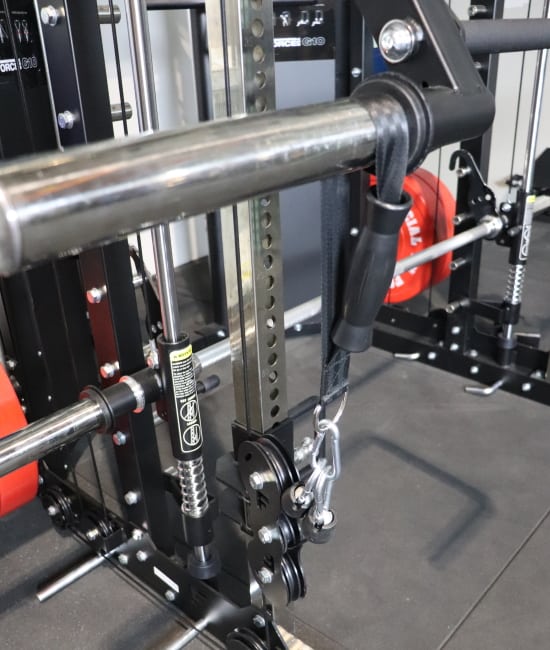
It’s also possible to use the band pegs to do band-resisted jammer arm exercises.
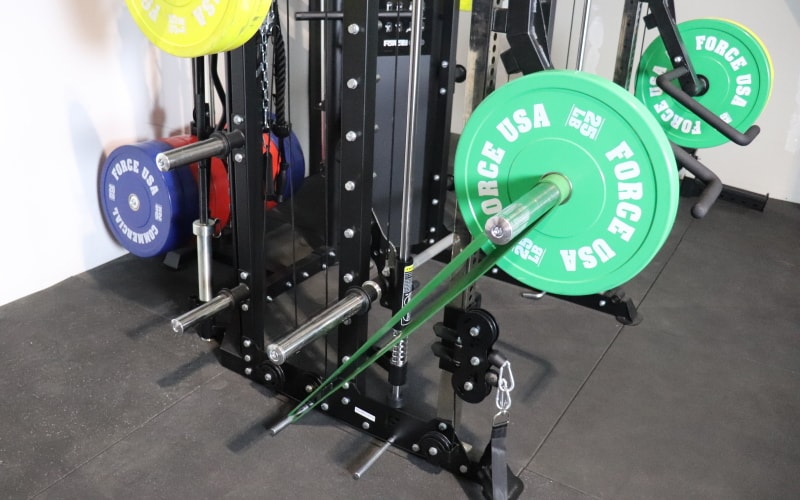
Jammer arms do take some time to adjust their height setting, but that comes with the territory for this type of attachment.
To install, just insert the threaded pin on the jammer arm through the desired hole. Secure it with a star knob onto the threaded pin on the other side of the upright.
It may feel fiddly the first few times you do it. But just remember (better yet, write down) your go-to height settings for your favorite exercises and it will be a breeze pretty quickly.
I think the jammer arms are totally worth the extra cost of the upgrade kit. In the beginning, they will take time to adjust, but honestly, you’ll get the hang of it pretty quick. It’s worth setup time in my opinion. You just can’t beat the pump you get from fixed-path movements.
Here are some of my favorite jammer arm exercises that you can do on the Force USA G10:
- Jammer arm lying flat bench press
- Jammer arm seated chest press
- Jammer arm incline press
- Jammer arm overhead press
- Jammer arm push press
- Jammer arm Romanian deadlift
- Jammer arm calf raise
- Jammer arm bent over row
- Jammer arm chest-supported row
- Jammer arm single-arm row
- Jammer arm power shrug
Vertical Leg Press (Optional)
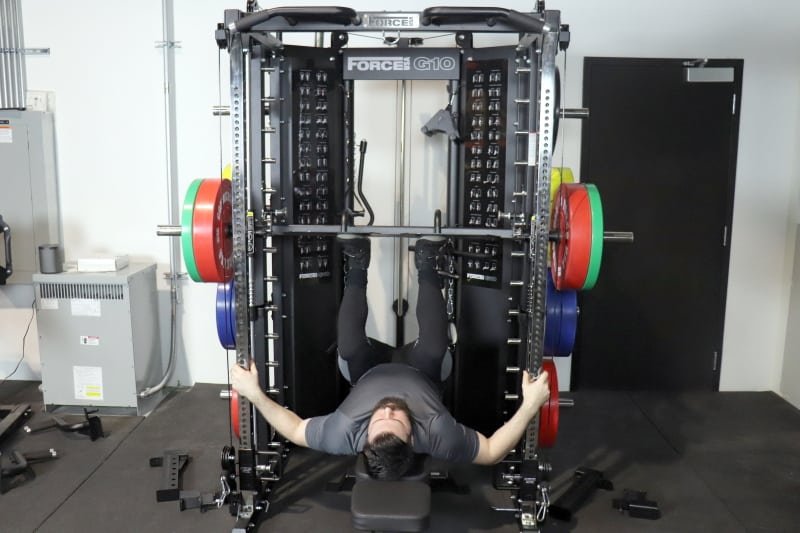
Buy the Force USA G10 – Use KING5 for 5% OFF »
You can add on a vertical leg press attachment when you purchase the upgrade kit for the Force USA G10.
All the other G-Series units come standard with a vertical leg press attachment except the G3 and G15, where it is an optional upgrade.
The vertical leg press is one of the best exercise stations for developing your thighs, especially your quads. Only barbell squats on the power rack do a better job.
The vertical leg press attachment consists of a large steel plate that’s built to install on the Smith machine bar. The attachment fits securely and does not wobble.

Installation is easy. Simply place the attachment over the Smith bar shaft and use the pop-pins to snap it into one of the three holes on the Smith machine hooks at the end of the Smith bar. The three holes offer you three different angles for the leg press plate.
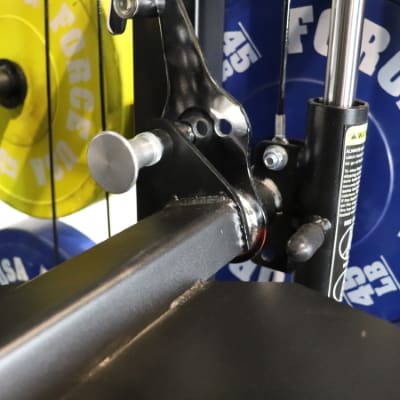
The other models that use this style of leg press – including the G6, G9, G12 and G20 – provide a single hole.
Changing the angle makes it easier to perform leg presses depending on your body and preferences.
By selecting the correct angle, you can focus more on the movement and less on stabilizing your ankle to keep the hooks from hitting the pegs that are part of the Smith machine safety catch system.
Now I like for the plate to be angled steeply, so that means I must take extra care when racking the weight at the end of the set. I have to press my feet quite far forward to hook the Smith bar onto the safeties. This makes it feel like the plate could slip when using heavier weight if I don’t keep my ankles stable.
If you also prefer the steep plate angle, I’ve got two suggestions:
- Stick to light/moderate weight for high reps. OR…
- …If you’re pressing heavy, then complete your set at the bottom of the range of motion by leaving the bar on the Smith machine safeties.
The gliding motion of the leg press is very smooth. The stability feels solid, too, since as I’ve mentioned you can modify the plate angle to your liking and the plate is securely attached to the Smith bar.
The attachment feels stable and the diamond steel pattern on the plate provides a non-slip grip on your feet. Again, the only time you may feel less stable is if you’re trying to rack a heavy weight when using the steep plate angle setting.
The plate width of 29.5” gives you plenty of space for narrow, medium or wide stance leg press variations. Even if you generally stick to one stance, it doesn’t hurt to mix things up every so often and this plate gives you room to do just that.
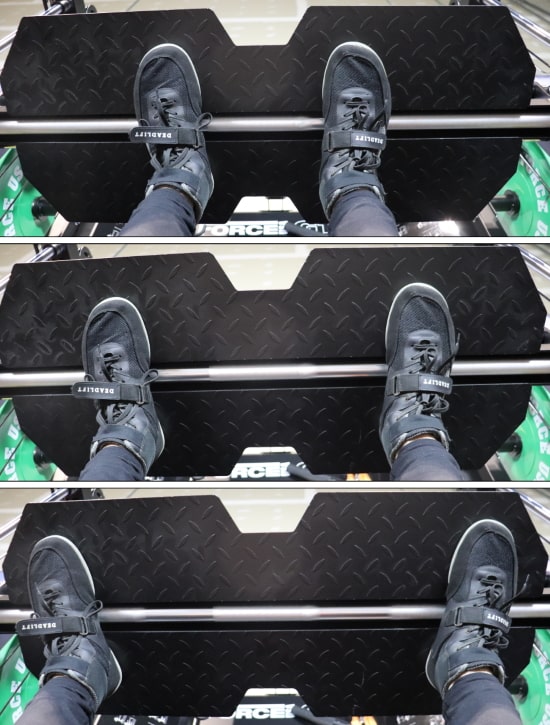
Now if all you’ve ever used are the 45-degree leg press machines found in commercial gyms, this is going to feel strange at first. You’ll lay on your back and put your legs up. Yeah, a little odd but you’ll adjust in a few sessions.
You can lay on the floor, but if you do so, you may want to get an exercise mat or an extra bench pad to put down for comfort.
I recommend just using your existing weight bench since it’s comfortable and you don’t have to buy anything extra.
One thing you’ll love about a vertical leg press is you don’t need to load up as much weight as you do when on a 45-degree leg press machine. That’s because all the weight is right above you. This saves time and effort when it comes to loading weight to set up the exercise.
While the Force USA G10 leg press attachment is like the attachment for the G6, G9, G12, G15 and G20, it is very different from the G3 attachment. Here’s how:
- The G3 plate locks in place parallel to the floor.
- The G3 plate has more play.
- The G3 leg press has handrails that turn inward or outward to rack or unrack the weight.
- The G3 plate is a half-inch more narrow.
- It takes longer to install the attachment on the G3 because you must manually insert two pins through the center of the Smith bar.
- The G3 leg press doesn’t feel as smooth since the G3 Smith machine is less smooth than the G10 Smith machine.
Landmine + T-Bar Row Handle (Optional)
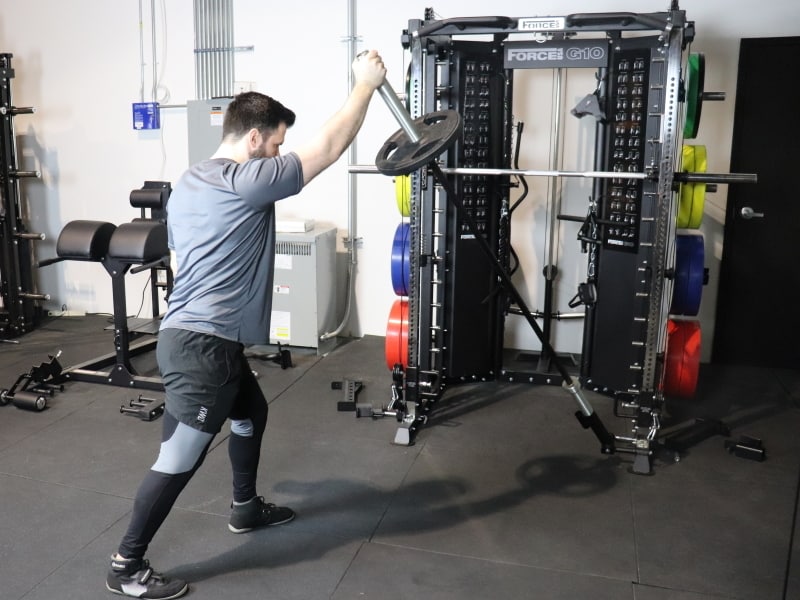
Buy the Force USA G10 – Use KING5 for 5% OFF »
The optional upgrade kit for the Force USA G10 All-In-One Trainer also includes a landmine attachment and a t-bar row handle.
The landmine attachment attaches to the front of the right foot of the rack. To use it, put one end of the barbell into the sleeve and load weight on the other end of the barbell. Now you can lift it in any direction because the landmine sleeve rotates.
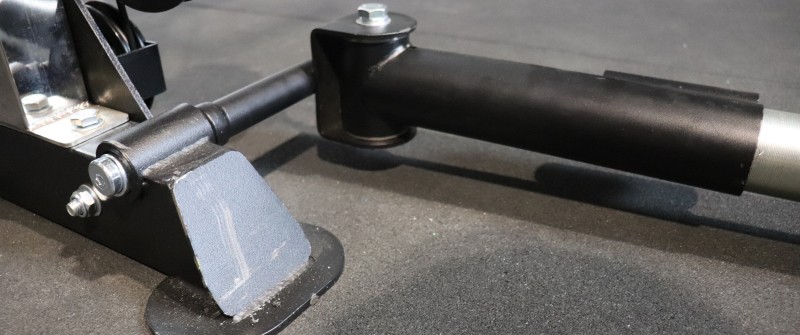
It is easily removed from the rack when not in use. It attaches using a washer that lets you insert or remove the attachment from the holder when you line it up. Once inserted, the washer drops down and locks the attachment in place.
The design makes installation and removal very easy, but it has a flaw.
You can’t apply pressure to the washer when in use. If you do, the attachment may come undone.
So, if you want to position yourself and the barbell diagonally past the midline of the rack, you must install the attachment on the inside of the rack. If you want you and the barbell to be to the outside of the rack, then you install the attachment on the outside of the rack.
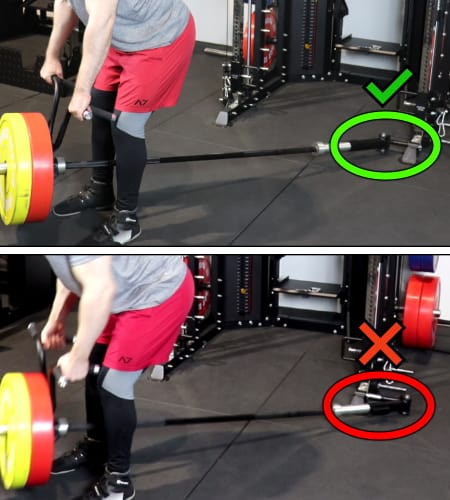
Here’s a quick video clip of me using the landmine attachment on the G15 with it installed the wrong way. Watch what happens:
The landmine attachment opens up a world of exercise possibilities for one little piece of equipment. It’s great for exercising the shoulders and your core.
The t-bar row handle unlocks the ability to do t-bar rows with the landmine. T-bar rows are one of my favorite back building exercises. It’s a great way to use a lot of weight to blast your mid-back and lats while also doing lower back and core work by stabilizing yourself while bent over.
The t-bar row handle slides onto the opposite end of the barbell. Then you load weights on behind it. You can use either a close neutral grip or a medium overhand grip.
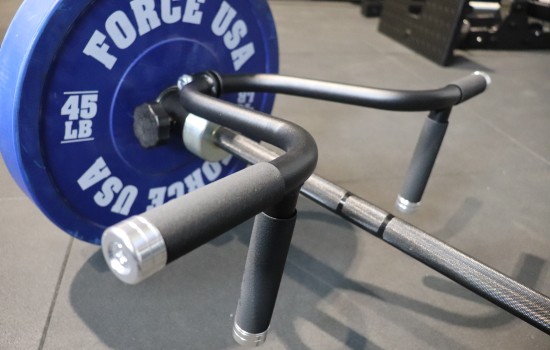
If you want a t-bar row landmine handle with more bells and whistles, I recommend looking at the Ironmaster Ultimate Row Handle, which I’ve reviewed here. It’s adjustable with different grip options, plus you can use it as a cable attachment.
In addition to t-bar rows and shoulder and core movements, you can get creative with the landmine attachment and do variations of traditional strength training movements (e.g. squats, deadlifts).
These are just a few of the exercises you can do using the Force USA G10 landmine station:
- Landmine floor press
- Landmine rotation
- Landmine shoulder press
- Landmine Z-press
- Landmine hand-to-hand pass
- Landmine hack squat
- Landmine front squat
- Landmine single leg Romanian deadlift
- Landmine t-bar row
- Landmine single arm rear delt row
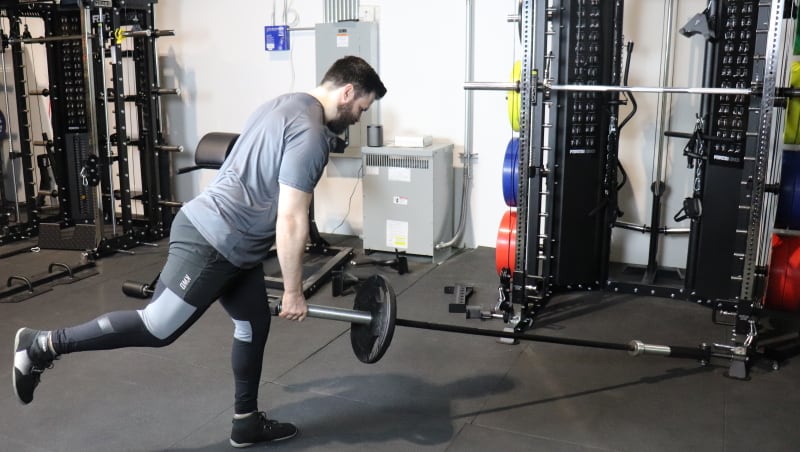
Now, if the landmine is the only optional attachment you want, I recommend you take a hard pass on buying the upgrade kit. Instead, just get third-party attachments like a standalone landmine attachment and a multi-grip t-bar row landmine handle.
But if the jammer arms, leg press or storage shelves are appealing then you’ll like getting the landmine and handle as part of the upgrade kit.
Storage Shelves (Optional)
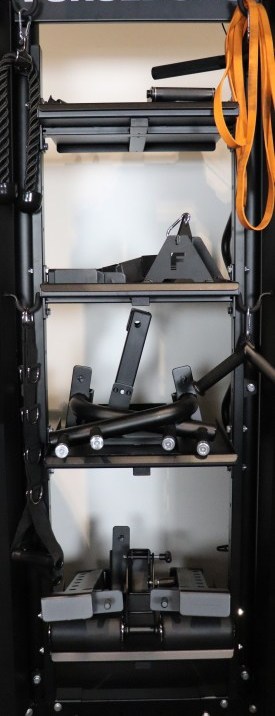
The upgrade kit includes 4 storage shelves.
These shelves add storage space between the opening in the back of the inside of the machine. Each shelf can be installed flat or at one of two angles. In addition, you’ve got 14 height settings so you can configure the shelves to your liking.
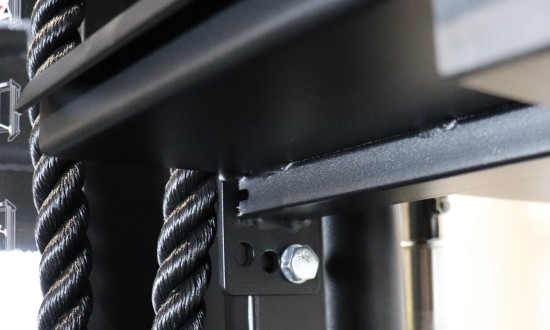
A short lip on the front and both sides of each shelf prevent items from falling off. That front lip comes into play if you install your shelves at an angle.
Unfortunately, the base of the shelf doesn’t have any gripping material. I think Force USA should consider adding an anti-slip lining to keep items from sliding when the shelves are installed at an angle.
Each shelf is 18”x16”. That offers ample storage for most lifters, especially when you install all four shelves.
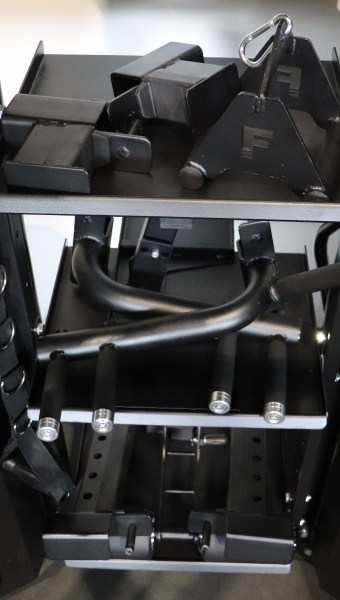
The shelves provide a handy space to store attachments and accessories. They are perfect for storing:
- Power rack attachments (e.g. j-hooks, spotter arms, dip handles)
- Cable accessories
- Bands and chains
- Barbell collars
- Lifting straps, sleeves and wraps
The shelves are sturdy enough to handle heavier items like dumbbells and kettlebells. You aren’t going to get a full set of kettlebells on these shelves, but you can store a few.
There’s also adequate storage for an adjustable dumbbell set. If you have PowerBlock dumbbells, these shelves let you store them at a slight angle. That’s perfect because PowerBlocks need to be at an angle to properly adjust them. If you go this route, you’ll only be able to put one PowerBlock dumbbell on a shelf. That ensures you have plenty of space o remove and re-insert the selector pin when changing the weight.
TV Mount (Optional)
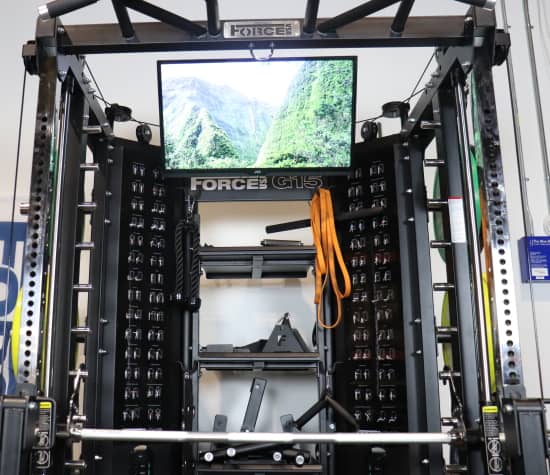
Can’t stand the thought of working out without some entertainment? The upgrade kit includes a TV mount so you can attach a flatscreen or curved TV to the G10 frame.
Some lifters don’t want a TV in their gym because it’s distracting. But some people find it useful because it provides entertainment between sets. And it can serve as a training tool if you use it to train along with workout videos.
The mount bolts to the top rear cross member and accommodates up to a 32” TV. The hole pattern follows the VESA standard, which is the mounting interface virtually all TVs use.
Each of the two pop-pin adjustment joints has three adjustment holes so you can adjust the height and tilt of the TV to your liking.
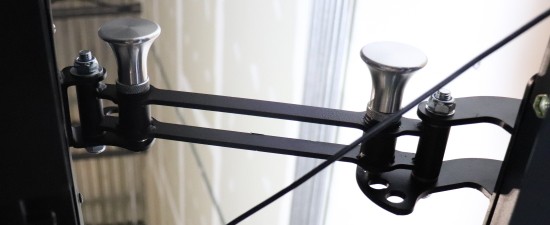
Leg Curl/Extension (Optional)
In November 2022, all of the G-Series models got access to an optional leg curl/extension attachment. All G-Series models except the G10 and G15 offer this attachment as part of an optional upgrade kit, which also includes jammer arms and in some cases dip handles.
For the G10 and G15, the leg curl/extension attachment is sold individually for $149. It was not added to the G10/G15 optional upgrade kit, which existed before the introduction of this attachment. Arguably, it would’ve made more sense to add the leg curl/extension attachment to the existing upgrade kit. However, that also would’ve increased the cost of the kit, which would be a negative if you wanted the upgrade kit but not this particular attachment.
The design of the leg curl/extension attachment is nearly identical for all of the G-Series models. The only difference is that the G-Series models with 5/8″ power rack holes like the G10 use a leg curl/extension attachment with a 5/8″ pin. Whereas the G-Series models with 1″ holes use an attachment with a 1″ pin.

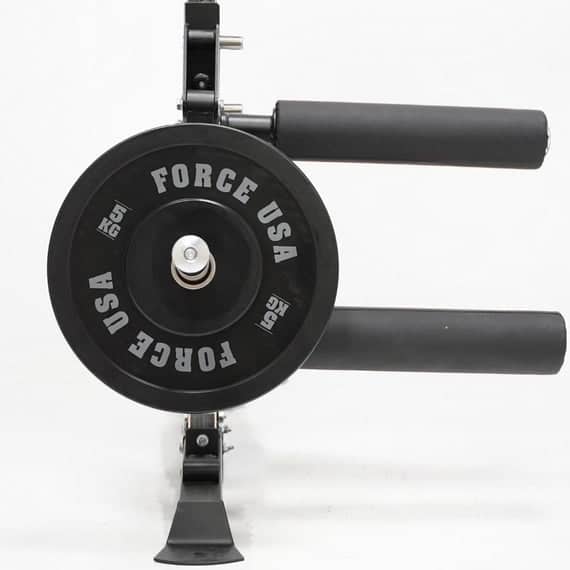
The G10 leg curl/extension attachment consists of:
- A frame that attaches to the power rack upright via a 5/8″ pin
- A lever attached to the frame via bolt that allows it to swing like it’s on a hinge
- A weight horn protruding from the bottom of the lever
- Two firm, upholstered foam roller pads: a removable one at the top of the frame and another affixed to the bottom of the lever
- A pop-pin that lets you the bottom roller height according to user’s leg length
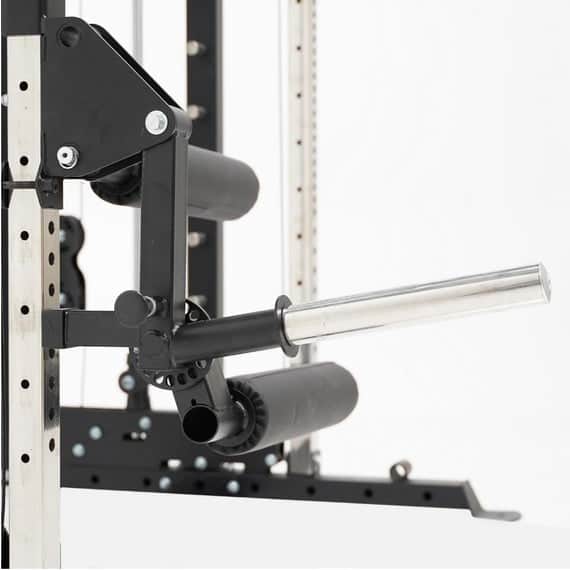
The attachment is easily mounted onto the power rack upright like a j-hook. The frame bracket wraps around the upright from opposite sides. It is secured by inserting a pin through the bracket and along the outside of the upright.
To increase or decrease resistance, simply slide weight plates onto or off of the weight horn. The horn is slightly tilted upward to prevent plates from slipping off.
This attachments unlocks the ability to do these 3 leg exercises:
- Seated Leg Extensions: To do these, you’ll need to sit on bench. Make sure the attachment is set up so the top roller is at or just above the height of the bench. If you do bilateral leg extensions, you may feel a slight difference in resistance between your left and right leg because the weight is located to side of the leg roller; rather than centerd. If this is an issue, simply train one leg at a time with unilateral leg extensions.
- Single-leg Standing Leg Curls: The design of this attachment only allows for standing leg curls rather than lying leg curls. Since you’re standing, that necessarily means you have to train one leg at a time. The benefit of doing one leg at a time is that you prevent one leg from taking over for the other; something that can happen with bilateral leg curls.
- Hip Thrusts: Remove the top roller to do hip thrusts with this attachment. You’ll need to place a bench behind you to put your back on and then position your hips under bottom roller. While this is effective for getting a good glute burn, you will have to switch to barbell or Smith machine hip thrusts once you get strong enough since you can only load so much weight on.
Missing Features
The Force USA G10 All-In-One Trainer isn’t lacking much when you compare it to the other G-Series all-in-one trainers. But there are a few features it lacks that other units have, including:
No Monolift
No monolift is available on the G10. Actually, only the G20 has this attachment. Because the G10 like the G20 is a higher-priced unit with Westside hole spacing, I thought a monolift would be a good fit.
No Bolt-down Capability
You can’t bolt the G10 down like the G3, G6 and G20. But you can’t bolt the G9, G12 and G15 down either. Honestly, when you consider the considerable heft of this unit, bolting isn’t necessary.
No Standard Plate Compatibility
Unlike the G3, G6, G9 and G12, the Smith machine sleeves cannot be adapted to fit standard weight plates. Both the G10 and the G15 are lacking in this department. The G10 plate-loaded weight carriage sleeves cannot be adapted for standard plate usage. Most people won’t ever notice this shortcoming because almost everyone uses Olympic plates.
Force USA Training App
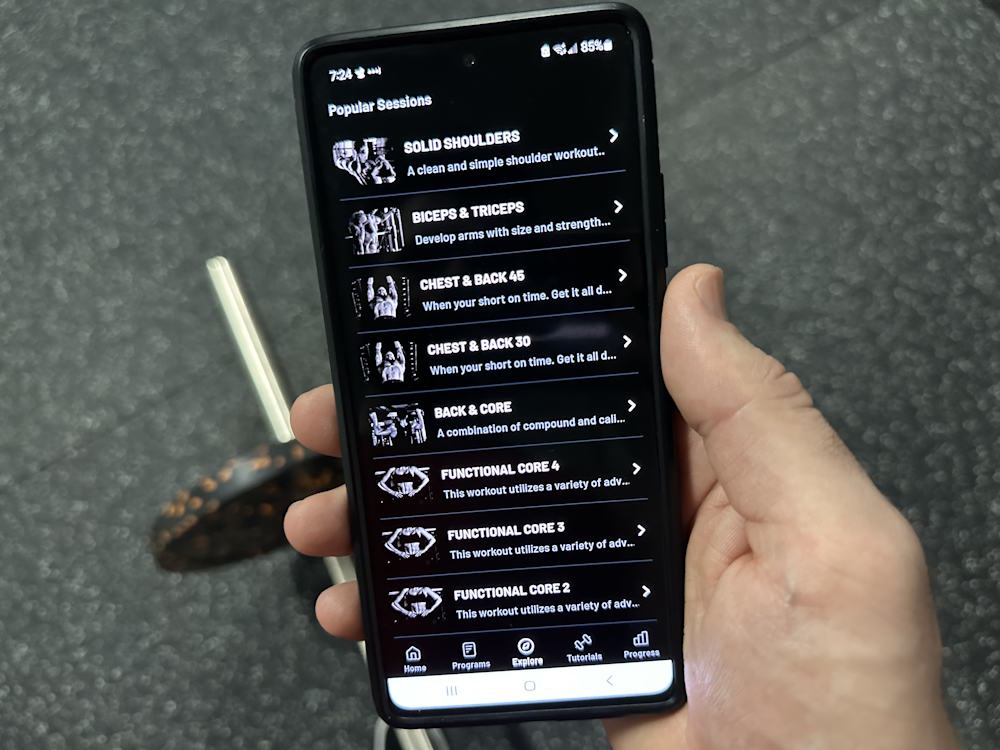
For those with a G10 or any G-Series machine where there are so many possible exercises, the main question is: “Am I using this right?”
The Force USA Training App tries to answer that.
Having tested this app made for the G-Series trainers, I found it surprisingly useful. Many companies create apps that feel generic. But this one is clearly more tailored with a real value proposition.
Here’s a breakdown:
- Workout Plans: The app has a lot of different workout plans for different goals and levels. Force USA plans to keep adding new ones over time so that there’s always a large and fresh selection.
- Exercise Tutorial Videos: There’s a large and growing library of exercise videos showing how to do all of the common (and some not-so-common) exercises on an all-in-one trainer.
- Track Your Progress: The app logs your workouts giving you access to all of your historical data. It uses this data to show your best numbers on your various lifts. There’s also a “Program Pyramid” on the main screen that gives you a visual snapshot of how well you’re adhering to your program.
- Easy to Use: The app is straightforward to use. It’s obvious how to move around the app and get to the part you want.
- Workout Flow: The workout flow is basically structured like an automation. You move through the session by simply tapping a button to get to the next set or exercise. Of course, within this, you can modify weights used and reps performed as needed.
- Rest Timer: There’s a timer that tells you when to rest between sets, which can be handy. This is part of the workout flow, so it’ll start as soon you tell the app you’ve finished the previous set.
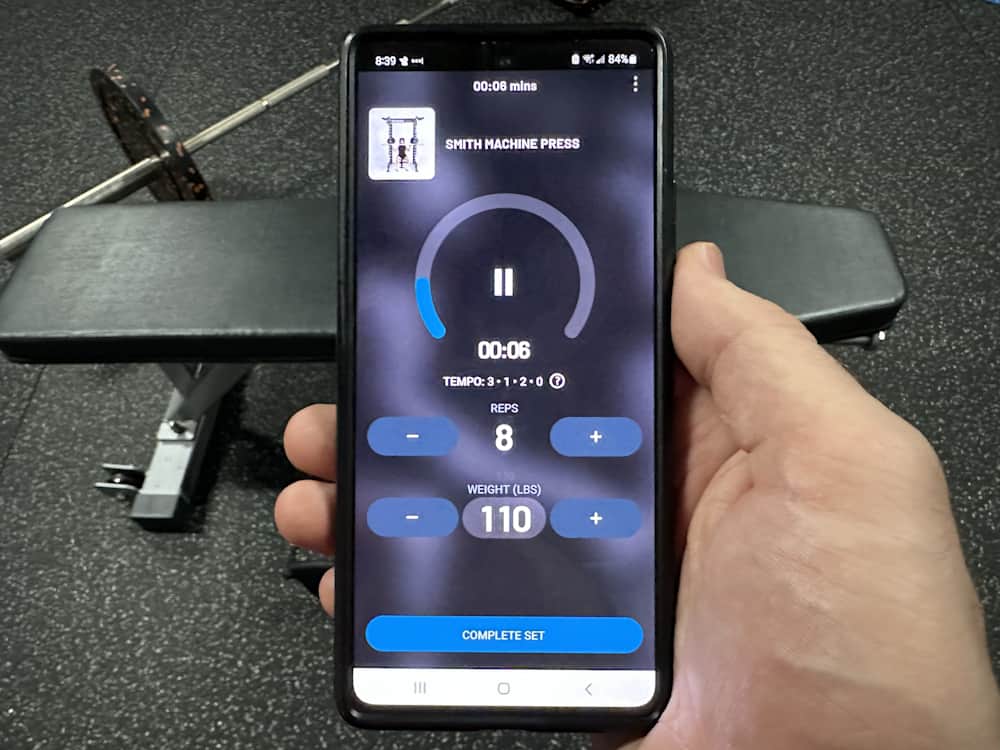
However, the app doesn’t let you create a custom workout from scratch. If you have a unique routine, it might not work for you.
I tried the app to get a good feel for its features. While it wasn’t for me due to my custom routine and my habit of using Google Sheets, I can see it being very useful for owners of the G10 or any other G-Series/X-Series owner — especially those who may not have a ton of experience.
Even without a G-Series or X-Series trainer, the app can be helpful as long as you have similar gym equipment.
Shipping
You can buy the Force USA G10 All-In-One Trainer in many different countries. Instead of a single retailer that sells to all countries, each country has individual online retailer(s) that you can buy from.
Before I tell you the best place to buy the Force USA G10 depending on where you live and go over region-specific shipping information, let’s cover the details that apply to all G10 orders.
- Your unit is shipped via an LTL freight shipping company.
- The freight company will contact you in advance to confirm the delivery date and time and make sure you are available to accept the order.
- Before you sign to accept the delivery, inspect the shipment to verify it is complete and undamaged.
- LTL freight only does curbside delivers. It is your responsibility to get the unit off your driveway and inside your home. Be prepared to do a little lifting.
- The base unit ships on a pallet and is packed in 1 oversized wooden crate and weighs 685 lbs.
- The optional upgrade kit ships in a separate crate that weighs 210 lbs.
- You’ll generally save on shipping by purchasing everything at once instead of buying each item separately. So if you need more items for your home gym, now’s the time to order it. One thing you’ll need to have is gym flooring that you can lay down before assembling the G10. Check out VersaFit mats. They’re priced fairly and are good quality mats made from thick solid rubber.
US Shipping
In the US, the Force USA G10 All-In-One Trainer is available exclusively through ForceUSA.com. Shipping is only available to the 48 contiguous US states.
Shipping costs a flat rate of $349. It’s the same regardless of the shipping destination.
The shipping price stays the same if you purchase the upgrade kit or any other equipment when you buy your G10 unit.
If you purchase the optional upgrade kit individually, the shipping is $99 and it will arrive via LTL freight.
Use my 5% off coupon code KING5 to save most of the shipping cost.
International Shipping
Shipping to Australia
If you need delivery to Australia, I recommend purchasing from Gym and Fitness. They’re the premier Force USA equipment retailer in Australia.
Plus, you can use my discount code KING5 and save 5% off your order at GymAndFitness.com.au.
Gym and Fitness has variable shipping costs depending on your shipping destination. However, I did find out that the average shipping costs for ALL G-Series units range from AU$130 to AU$480. Shipping by state, from the low end to the high end: QLD, ACT, NSW, SA, VIC, NT, TAS. The average across the entire country is AU$260.
You may qualify for free shipping! If you aren’t in the Northern Territory, Western Australia or Tasmania, you can get free shipping if you sign up for the Gym and Fitness loyalty program.
Shipping to Canada
The only place you can buy the Force USA G10 if you live in Canada is at ForceUSA.ca.
Use my KING5 coupon code and save 5% on your order.
Delivery costs in Canada vary based on your location. Shipping runs a bit higher in Canada than in the US, but it’s not crazy expensive.
Remember, your shipping is the same if you add additional items to your cart when you buy a base unit. If you are thinking about the upgrade kit or any other Force USA equipment, go ahead and buy it now to save on shipping.
Shipping to the Middle East
If you need delivery to the Gulf countries, you can buy your G10 from Garner Fitness Supplies (Garner.ae) or Alqudra Sports Equipment (Alqudra.sa). Both sites are owned by the same company, but they serve different areas.
Yes, my KING5 coupon also saves you 5% off at these sites as well.
Garner Fitness Supplies is based out of Dubai and they maintain a showroom there if you want to see the equipment yourself. They ship to the UAE, Kuwait, Bahrain, Oman, Qatar and Saudi Arabia.
Alqudra Sports Equipment is located in Saudi Arabia where they have a showroom in the city of Al Khobar. They ship to Saudi Arabia, Kuwait, Bahrain, Oman and the UAE.
Shipping costs depend on the delivery address. Usually, you’ll save on shipping by purchasing from the retailer closest to you.
Who Should Buy the Force USA G10?
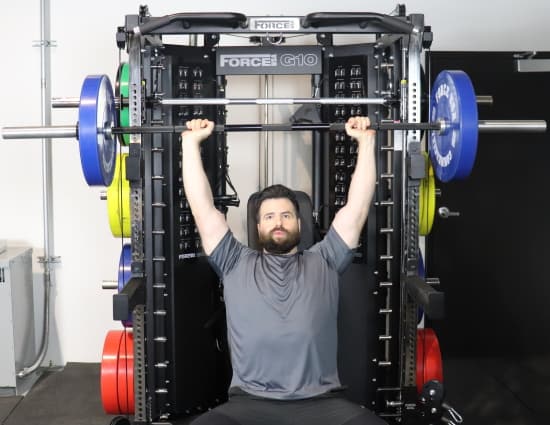
Buy the Force USA G10 – Use KING5 for 5% OFF »
The Force USA G10 All-In-One Trainer is a great all-in-one trainer and it is well suited for many types of lifters. The unit may be all-in-one, but that doesn’t mean it’s perfect for everyone.
Let’s look at who benefits the most from the G10.
Powerlifters: The Force USA G10 is a particularly well-suited all-in-one for powerlifters. Here’s why:
- The Westside hole spacing is really better-than-Westside hole spacing. You get uniform 1” hole spacing throughout the power rack uprights. This spacing provides ultra-precision when attaching the j-hooks and spotter arms. You’ll unrack the bar from your ideal position and the safeties will be exactly where you need them if you need them. You’ll maximize your performance and safety on heavy powerlifting movements like bench and squat.
- The plate-loaded weight carriage is just waiting for you to load it up. You’ll get much more resistance compared to a selectorized weight stack system. For powerlifters, more weight is better.
- NOTE: I think the G10 is a superb option for those who engage in powerlifting-style training and also want a cable system and Smith machine all in a single piece of equipment. Competitive powerlifters, move along. I’m not talking to you. You want a full power rack like the Force USA X20, not an all-in-one that has a half rack.
Niche commercial gym settings: The Force USA G10 provides the perfect all-in-one trainer for small, niche gym settings. If you are looking for a unit for an office gym, hotel gyms, fire department gyms, police department gyms and community/rec center gyms, you should seriously consider the G10. Here’s why:
- These gym settings are usually small and much of the room is consumed by cardio equipment. A small, compact unit allows you to offer a wide range of resistance training equipment in a small footprint while satisfying the needs of the users who want to lift.
- These gyms rarely have many people in them at once. No need to worry about people waiting to use the equipment.
Family use: The Force USA G10 provides an all-in-one gym that’s suitable for users with different levels of experience. An entire family can use it for their individual needs. Because the interchangeable 2:1 and 4:1 pulley ratio allows for heavier or lighter weights and increments on cable exercises, novices and heavy lifters can use the same equipment. Novices will appreciate that the counterbalanced Smith machine starts at 0 lbs.
Low ceilings: Not everyone has 9 (or even 8) foot ceilings. Pick the G10 if you want a premium all-in-one trainer and you need to put it in a room with low ceilings. The trainer requires no more than 7’8” (92”) to do full range of motion pull ups without bumping your head on the ceiling.
Who Shouldn’t Buy the Force USA G10?
If you are set on having a 1:1 pulley ratio, don’t buy the Force USA G10. If you are a very strong, experienced lifter and won’t share your machine with a novice, get the G20 instead. As a backup to the G20, I suggest the G12.
If you’re looking for a taller unit, take a pass on the G10. If you want to do lat pulldowns with a full stretch and sit on a bench, the G10 isn’t for you. Now, I don’t mind sitting on the floor for pulldowns, but I get that some people insist on sitting on a bench.
If you are quite tall yourself, you’ll probably want a taller model. The G10 has an 80” (6’8”) internal height which might feel cramped if you’re really tall. I recommend the G20 as the top pick for tall lifters, followed by the G6.
Finally, if the G10 isn’t in your budget, it isn’t the unit for you. If you need something less expensive, look at the G3. It’s $1,000 less.
If you don’t want to pay cash, you can always apply for financing through Affirm.
Force USA G10 vs Force USA G15
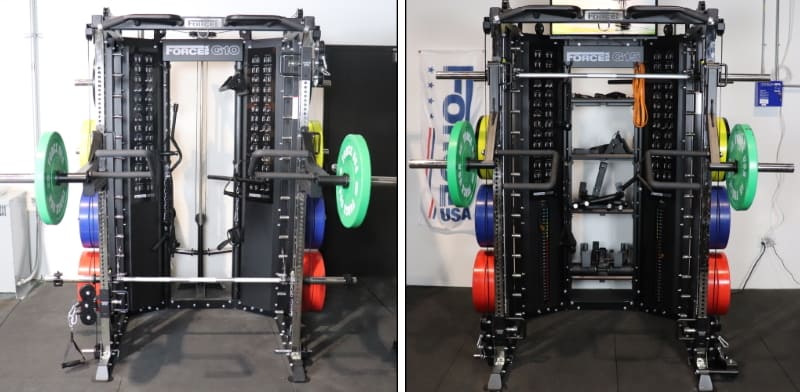
The G10 and G15 are almost the same machines. If your search has narrowed to these two units, there are three things to consider: training style, budget and space constraints.
Training Style
Is your training style better suited for a selectorized or plate-loaded functional trainer?
Here’s when I recommend buying the Force USA G10 over the G15:
- You want to be able to load on lots of Olympic plates so you can use MUCH heavier cable resistance than with the G15’s weight stacks.
- You don’t need to rapidly change the weight between sets.
- You aren’t bothered by the extra time and effort required to change the weight on a plate-loaded system.
- There’s no need for two people to do cable training at the same time.
Here are the training scenarios where I think buying the Force USA G15 makes more sense:
- The rapid weight change capability of the selectorized weight stacks is crucial to your training style (e.g. drop sets, super sets).
- You don’t want to deal with the extra time and effort required to adjust the weight on a plate-loaded system.
- You want the ability to train on one side of the functional trainer while someone else trains on the other.
Budget
How much can you afford to spend on a new all-in-one gym?
The G15 will cost you $2,500 more than the G10. If you want the G15, can afford it and won’t regret spending the extra – go for it. Otherwise, buy the G10.
If you can afford the higher cost of the G15 but are leaning towards the G10, get the G10 and consider the price savings a bonus. Maybe use it to buy the optional upgrade.
Space Constraints
The model you buy may depend on the size of the space where you will use it.
The G10 footprint is the same as the G15 footprint except for the depth. The G15 requires 53” of depth. The G10 plate-loaded weight carriage requires an extra 20” of room. Plus, you need an extra 6” or more so you have plenty of room for the weight plates.
Don’t forget to figure in some space in front of the unit so you can actually exercise.
If you don’t have room for the larger G10 unit, then the G15 is the obvious choice.
Overall Rating
Force USA G10 All-In-One Trainer
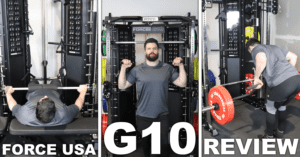
The Force USA G10 is the best all-in-one trainer if you're looking for a plate-loaded functional trainer that can switch between a 2:1 and 4:1 pulley ratio. It's more budget-friendly than the G15, which is the same as the G10 except that it uses a selectorized weight stack system. The G10 is also great for strength-focused lifters since they can use a lot more weight on the plate-loaded carriage than on the selectorized version. And if you want jammer arms, the G10 is one of the only G-Series units with them available.
Product Brand: Force USA
Product In-Stock: InStock
4.8
Force USA G10 vs G3 vs G6 vs G9 vs G12 vs G15 vs G20
The Force USA G-Series lineup includes a total of 7 all-in-one trainers. The G10 and G15 are the newest models.
Every model serves a slightly different user and each has its own pros and cons. You should consider your needs, preferences and budget when picking a unit.
If you’ve read this far and have decided the Force USA G10 is right for you, just click the link below and buy it now:
Buy Now – Force USA G10 All-In-One Trainer »
Still not sure? Check out my comparison guide on the Force USA G3 vs G6 vs G9 vs G10 vs G12 vs G15 vs G20.
You’ll get a direct comparison of each model from a high level across all the key features and specs.
Still need more information? Check out the individual product pages:
Check Current Prices – Force USA G3, G6, G9, G10, G12, G15 & G20 »
Remember to use the discount code KING5 when you buy any G-Series unit and save 5%.
P.S. To my Aussie and Canadian readers out there — Remember that you also have access to the same KING5 discount code for 5% off at GymAndFitness.com.au at ForceUSA.ca, respectively.

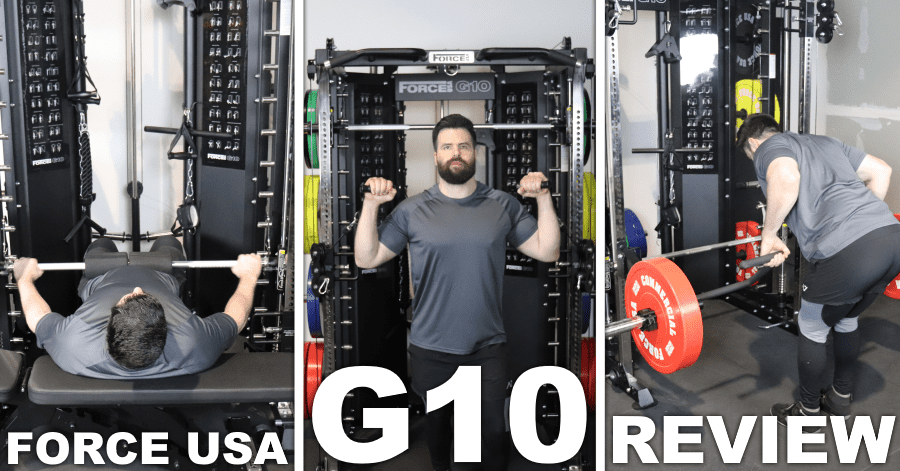
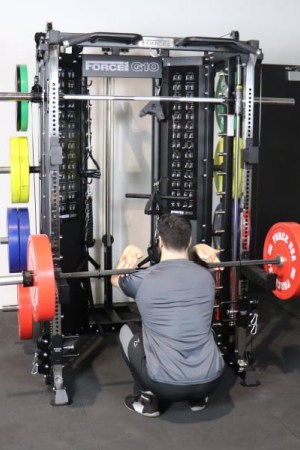


Hey Alex, great review as usual. Just wondering what your thoughts are on the G10 vs G9? The G9 to you was the most underated and best bang for your buck. Also you liked a trainer with 1:1 ration. I am in Australia and GymandFitness no longer sell the G9, there are other suppliers who do sell them but I finding that the G9 is more expensive ($3499) than the G10. G10 is currently $2999 at Gymandfitness and probably the reason why your 5% discount doesnt work.. If they are both roughly the same price, which one would you go for? Cheers
Thanks, Sol. Yes, it looks like my coupon code isn’t working on the G10 since it’s currently on sale and GymAndFitness for AU$2999 (usually AU$2999).
Assuming a similar price between the G10 and the G9, I would go with the G10 for a few reasons:
With the G10’s price actually being lower than the G9 at the moment, it’s an even better value than if the prices were similar.
Hey Alex, Sol here again. I am set on the G10 over the G9. However I also want a leg press which means I need to get the upgrade kit which includes leg press, jammer arms etc. I can get the g10 + upgrade kit from gymandfitness (Australia) for $3500 (black friday sale). However if I spend an extra $500 more, I can get the G6 for $3999 which includes leg press and pin loaded. What are your thoughts on G10 with upgrade kit vs G6? Cheers
At those prices, if you’re okay with the shorter unit height and a plate-loaded setup, I’d go with the G10 with the upgrade kit over the G6. The availability of jammer arms (which I’m a fan of) and closer hole spacing are what tip me in favor of the G10 in this scenario.
Also the nice thing about plate-loaded setup is that you’ll be able to add on plenty of weight for heavy exercises like rows and lat pulldowns, without having to do any workarounds like on the G6.
Of course, if either the selectorized setup or a taller unit height is a must-have for you, then the G6 is the obvious choice.
Thank you very much. Such a comprehensive and detailed review that cannot be found anywhere.
You’re very welcome!
Brilliant review. Well done.
A little confused on the spec of steel in the uprights where the j hooks and safeties attach though. Force USA advised by email that it’s 2.6mm thickness making it 12 gauge not 11 gauge.
Can you confirm please. There are none here (Aust) to inspect unless you buy and ship first.
All the best
Hi Alex, I have been reading your G series reviews for some time know and really appreciate the level of detail you have shared with us as potential buyers. I am very interested in getting the G10, specially for the smith machine functionality. Incline press on the Smith is something I am really interested in. I want to combine this purchase with the REP blackwing adjustable bench. Do you think the G10 has enough interior depth to be able to do incline at a right/safe angle ? (either facing into the inside of the G10 or to the outside) The full length of the bench is 59.5″ (front handle to back wheels. Would much appreciate your feedback.
You’ve got great taste in benches. Since I can’t physically test the Rep Blackwing in the Force USA G10, I can’t say for certain if that bench would fit properly in the G10 to allow for incline Smith work.
If you were to try to get it to work, in either direction, you’d want to skip out on installing the optional shelves (or simply don’t buy them in the first place) since they take up valuable internal depth.
I tested the G10 using Force USA’s Pro Series FID bench, which is 52″ long, a full 7.5″ shorter than the Blackwing’s length. That makes me think your body may still be too far forward while under the Smith bar when the bench is all the way back.
That said, I have a lot more confidence that you’d be able to make incline Smith machine exercises work by orienting the bench so that it faces the inside of the G10. This is because you can bring the bench a lot more forward before it touches the rear frame of the G10 (compared to how much you can move the bench back before the benches back feet touch the rear frame). Basically, you have more room this way and can achieve lower incline settings before potentially running into obstructions.
The only thing that can be an issue in this situation is that your legs/feet can hit into the back of the G10 — something that would potentially only happen on low-incline settings (you’ll have enough clearance on high incline settings). However, the “workaround” for if/when this happens is to put you legs through gap in the back of the unit (i.e. where the storage shelves would otherwise go). Check out this video of me on the Force USA bench facing inward doing Incline Smith bench press:
As you can see in that video:
Again, I can’t give you a 100% certainty, but hopefully this gives you a better idea of the likelihood of it working, and how it would work best (inward).
Dear Alex, I wanted to thank you for the detailed response and suggestions. After many weeks, I made my mind and just purchased the G20 (used your discount code) after months of debating in my mind between G9, G10, G15 and G20. Also thought many times about REP with Athena attachment but the Smith Machine was a key functionality in my mind. Also went ahead with the REP Blackwing and the G20 gave me all the internal depth I needed. A very significant investment but I try to justify it thinking I am investing in HEALTH for the next many years. Once setup, I will share pictures for your reference in case you want to use them how. One thing I struggled with was dimensions and how combining equipment would fit together.
Thanks for the support! And great choice on the G20. That will certainly give you the internal depth you need for using the Blackwing on incline for Smith work. I look forward to seeing the photos. The install process will be long, but definitely worth it.